2023_164 C
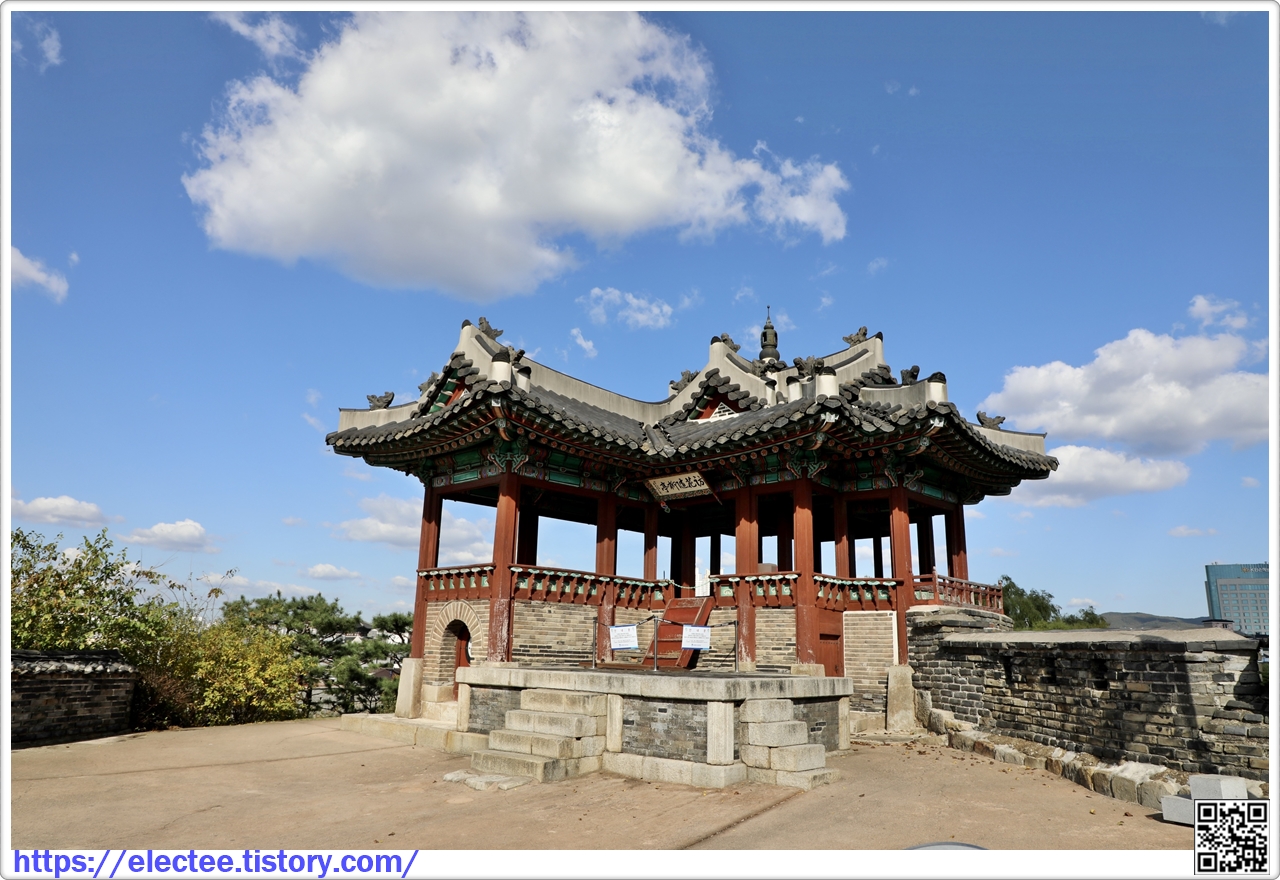
2023. 10. 20. (금) 07:40~12:50, 5시간 10분간 순성, 1시간 10분 휴식 포함, 7.4km 이동
수원 화성의 성밖 풍경이 너무 아름다워 왜 진작 밖으로 돌지 않았을까 하는 후회도 잠깐 생긴다.
수원은 가까우니 계절마다 또는 심심할 때 자주 와야겠다.
가장 높은 팔달산 정상이 145.5m에 불과하니 산행이 아니라 산책 정도로 생각하면 된다.
이젠 입장료도 사라진 데다 팔달구청 옆에 수원화성박물관까지 있다.
화성박물관까지 관람하면 수원화성애 대해 누구보다 잘 알게 된다.
이번 편은 수원화성의 바깥 풍경 마지막 편이다.
수원화성 순성 코스
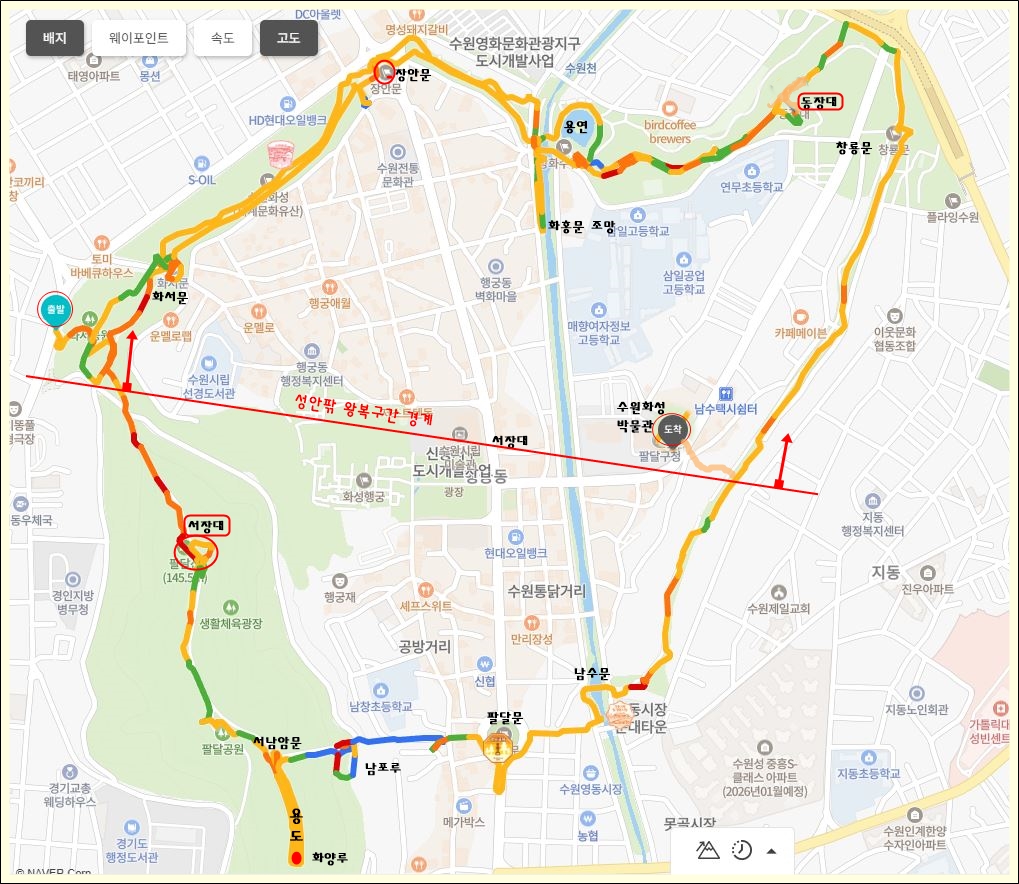
철 모르는 제비꽃이 펴 지나가는 즐풍을 기쁘게 한다.
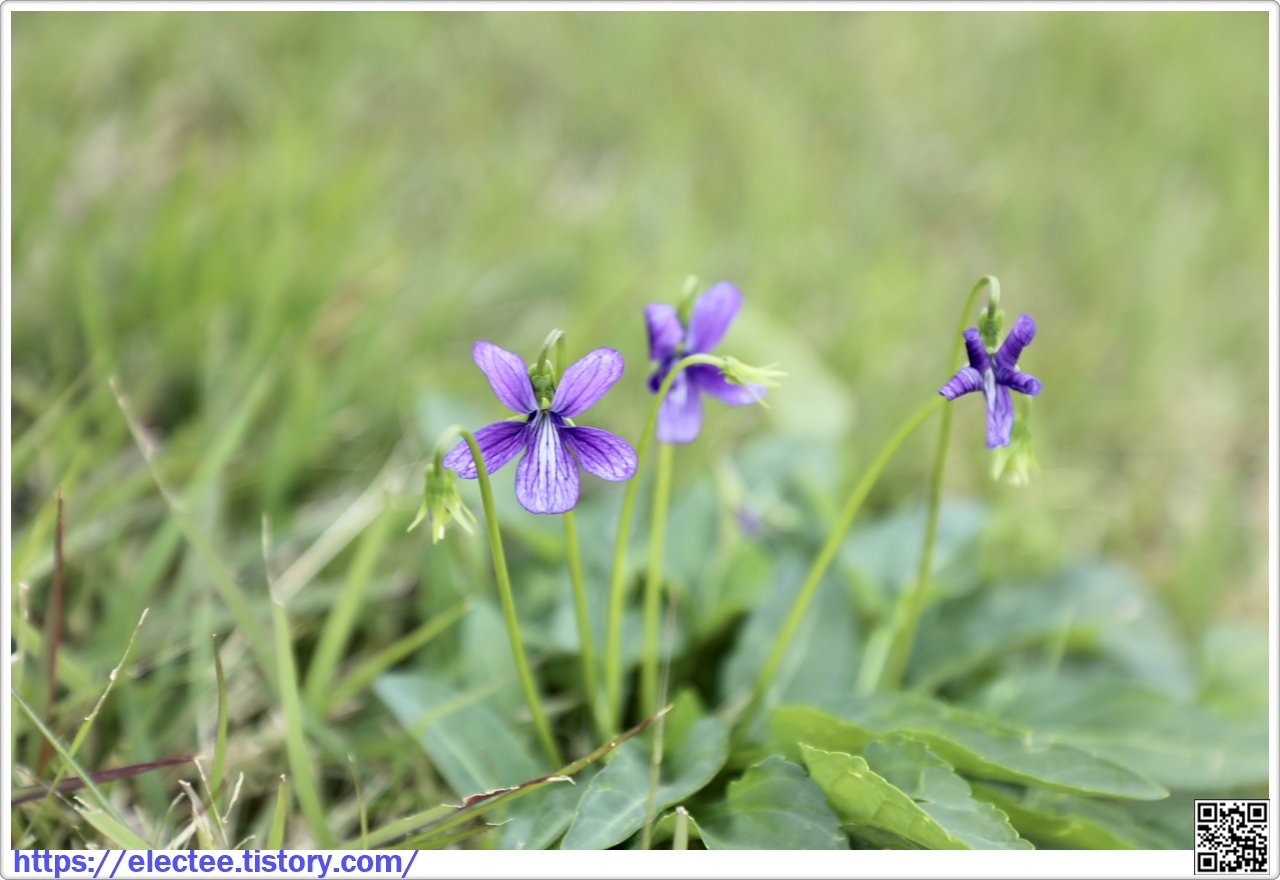


이 구역에서 가장 돋보이는 방화수류정이 주변 건물과 섞여 뽀대가 안 난다.
멀리 장안문도 드러났다.

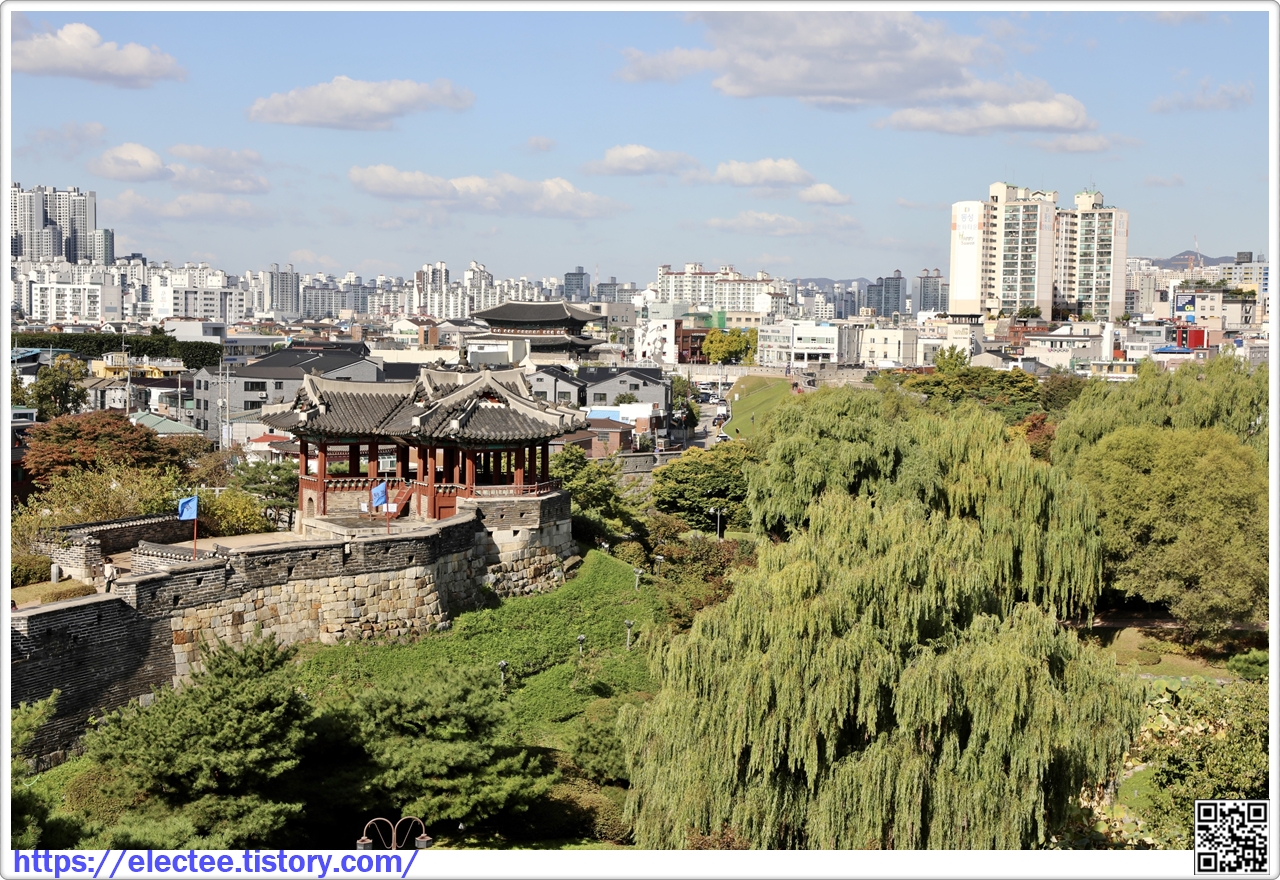
앞쪽에는 동암문은 수원 화성을 만들 때 의도대로 잘 드러나지 않는다.
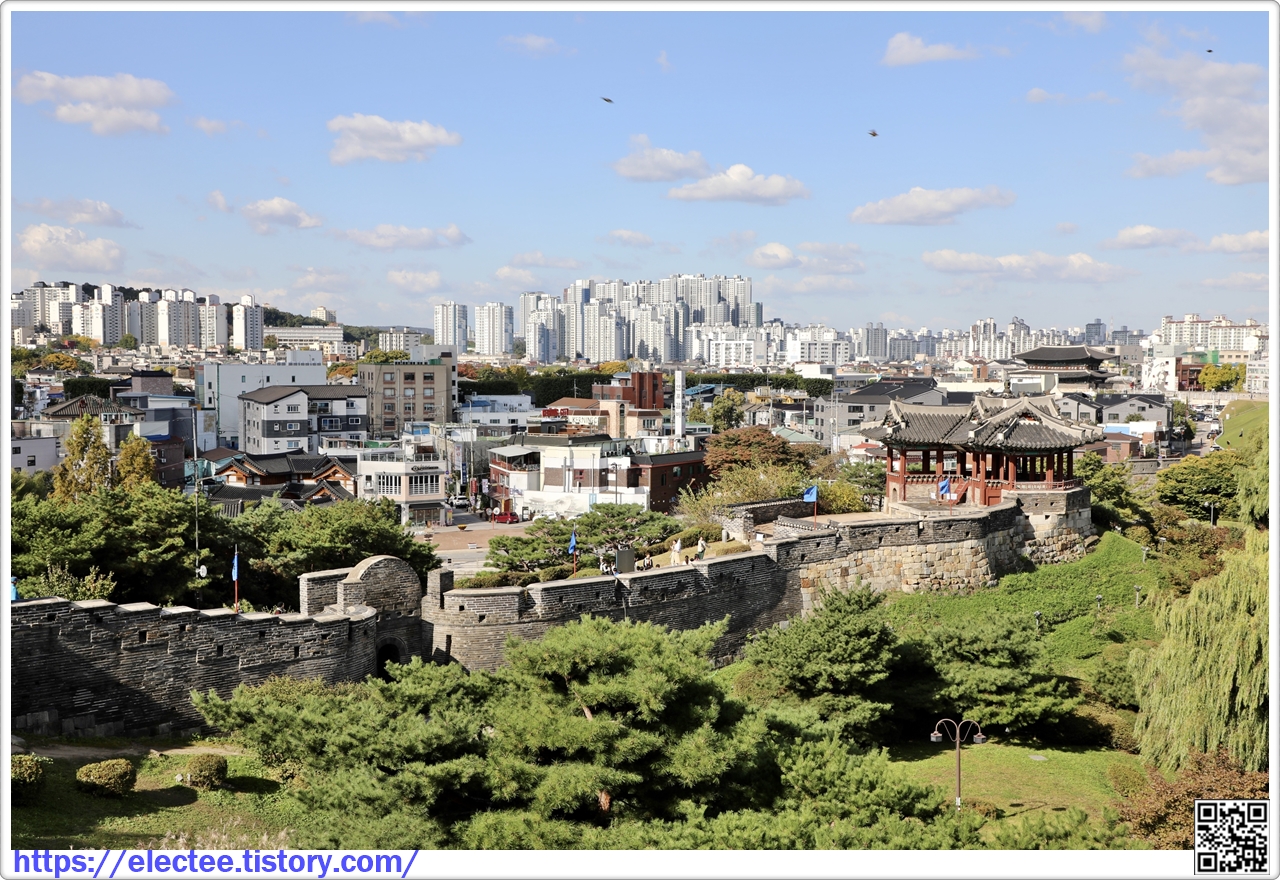
방화수류정 위치가 높아지며 배경에 많던 건물이 가라앉았다.
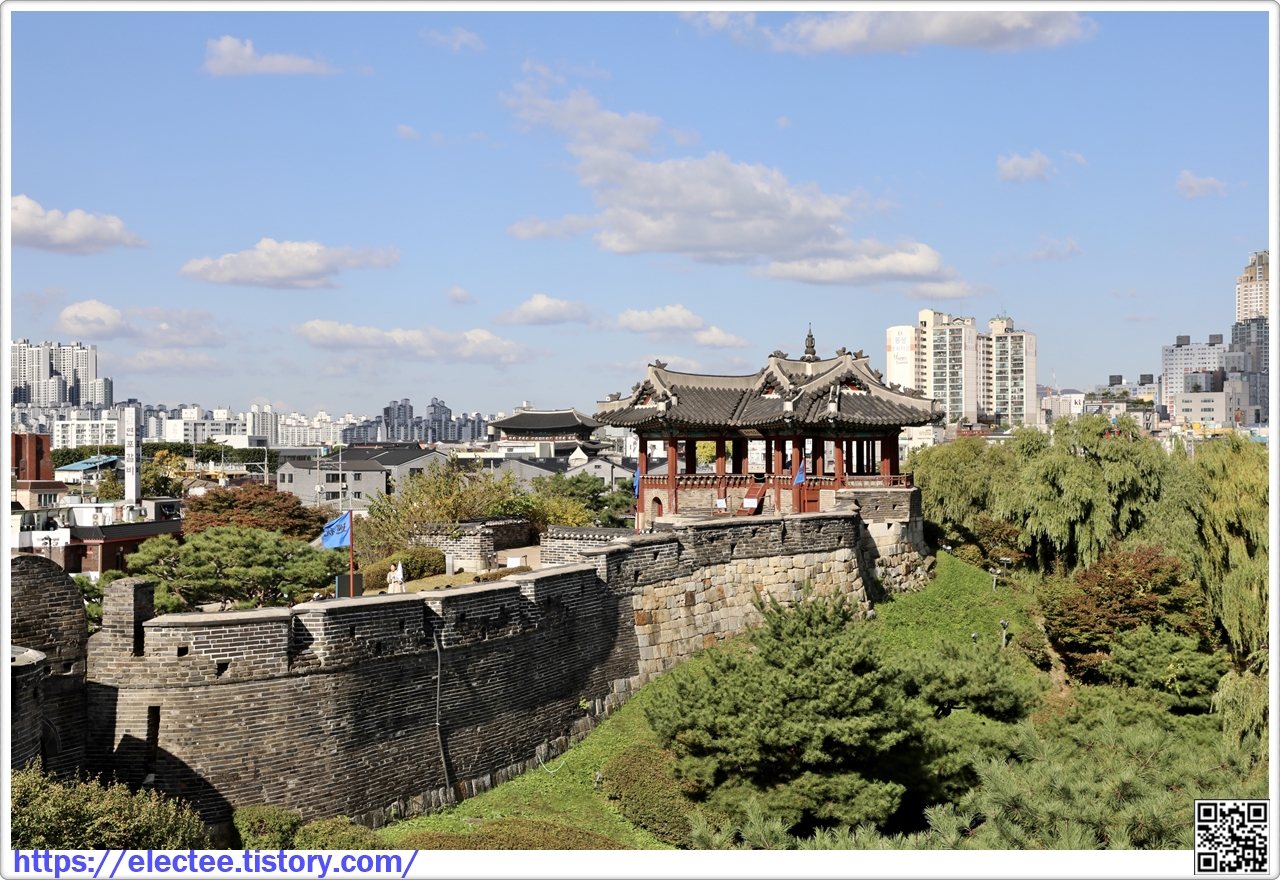
북암문 北暗門
북암문은 화성 북쪽에 낸 비상 출입문이다.
암문이란 깊숙하고 후미진 곳에 설치하여 적이 모르게 출입하고 군수품을 조달하던 문을 의미한다.
화성에는 5곳의 암문이 있었는데 모두 벽돌로 만들었다.
북임문은 지형에 맞춰 좌우 성벽까지 벽돌로 둥글게 만들었다.
문 위에는 몸을 숨기고 적을 감시하기 위해 여장을 세웠는데 반원형은 원여장, 장방형은 비예라고 부른다.
축성 당시의 모습이 잘 남아 있다.
Northern Secret Entrance
A secret entrance, called ammun in Korean, was an emergency passage used to bring supplies
and food into the fortress, without being noticed by the enemy.
In Hwaseong Fortress, there were a total of five secret entrances.
The Northern Secret Entrance was built on high ground, and stone staircases were built both inside and outside.
All secret entrances in the fortress are built of brick, but here, bricks were also used for the walls on each side
of the entrance.
These brick walls have maintained their original structure built in 1796, and the entrance was repaired in 1972.
(안내문)

동북각루, 방화수류정 東北角樓 訪花隨柳亭
동북각루는 화성 동북쪽 요충지에 세운 감시용 시설이다.
용두龍頭바위 위에 각루를 우뚝 세워 주변을 감시하고 화포를 쓸 수 있도록 했다.
군사시설이지만, 아름다운 연못과 함께 있어 경치를 즐기는 정자로 많이 쓰였다.
정자의 별칭은 방화수류정 訪花隨柳亭이다.
정조는 이를 '현릉원이 있는 화산花山과 수원 읍치를 옮긴 땅 유천柳川을 가리키는 뜻'이라고 풀이했다.
방화수류정에는 온돌방 한 칸이 있었다.
보통 군사들의 휴식을 위해 각루 1층에 온돌방을 만들었는데,
방화수류정에는 임금을 위해 2층에 온돌방을 두고 창문을 설치했다.
조선 정조 21년 0137) 정월, 정조는 방화수류정에서 활쏘기를 하고 주변의 아름다운 경치를 읊은 시를 지었다.
지금은 온돌방과 창문이 사라졌지만 원형의 건축물이 잘 남아 있다.
Northeastern Corner Pavilion (Banghwasuryujeong Pavilion)
A corner pavilion, called gangnu in Korean, was built on the high ground of the fortress to watch the surrounding area and to be used for leisure.
The name comes from the fact that there is one such pavilion at each of the four corners of Hwaseong Fortress.
The Northeastern Corner Pavilion is an L-shaped building with a sophisticated and complex roof design.
It is commonly known by the name "Banghwasuryujeong bitains."
The pavilion overlooks a large pond, and the harmony of the pavilion and its beautiful surroundings is the most outstanding among the various structures in Hwaseong Fortress.
Originally, the pavilion was built as a command center, but over time, it came to be used
as a place for enjoying the scenery rather than for military purposes.
The pavilion was dismantled to be rebuilt in 1934.
(안내문)
방화수류정은 몇 번을 봐도 질리지 않으니 북암문을 통해 잠시 들어왔다.

방화수류정을 빠져나오며 바라보는 동북포루
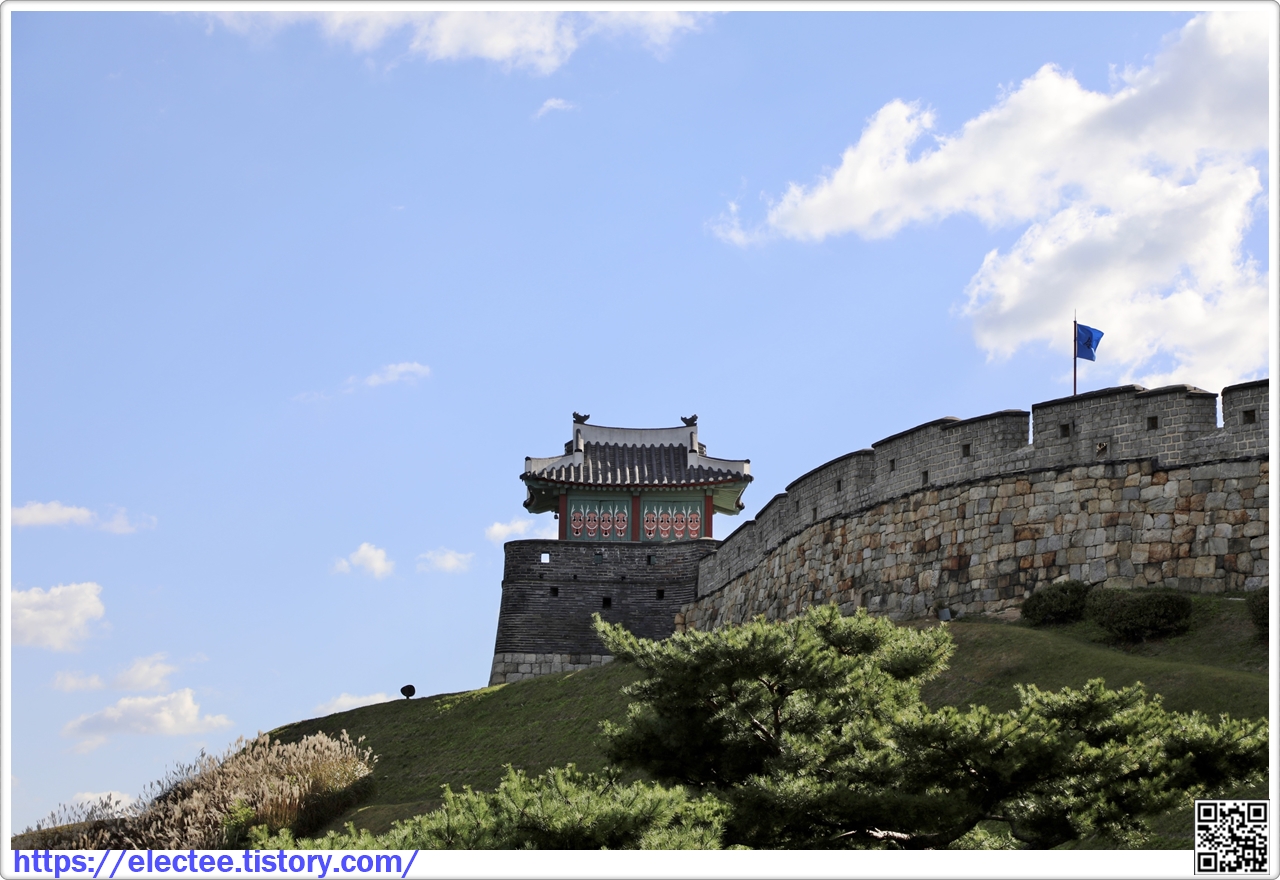
용연 龍淵
용연은 화성의 북쪽 성밖에 있는 연못이다.
금강산 구룡연을 비롯해서 전국의 이름난 명소에 용연이라는 명칭이 두루 쓰였고 갖가지 전설이 있다.
화성의 용연은 용머리처럼 생긴 용두 바위에서 유래했다.
용두 바위 위에 있는 방화수류정은 '용두각'이라고도 부른다.
「화성성역의궤」에는 용연이 반달처럼 생겼고, 용두 바위는 물고기를 잡는 조대로 쓸 만하다고 기록되어 있다.
용연의 물이 넘치면 서쪽의 출수구를 통해 수원천으로 흘러 나간다.
출수구에는 용이 되기 전 단계의 짐승인 이무기 상을 새겼는데 원형이 잘 남아 있다.
용연에 비친 달이 떠오르는 모습인 '용지대월龍池待月'은 화성에서 보아야 할 아름다운 경치로 꼽힌다.
Yongyeon Pond
This pond is called "Yongyeon" meaning "pond where a dragon stays."
The name comes from the rock under the Northeastern Corner Pavilion (Banghwasuryujeong)
called Yongdubawi, meaning "dragon head rock."
In Korea, there are a number of other ponds with the same name, each with its own legend related to dragons.
There is a small, round island in the middle of the pond, which is a common feature of traditional Korean ponds.
The moon's reflection in this pond is considered one of the most scenic sights of Hwaseong Fortress.
1796년(정조 20) 조성 | 1976년 주변 정비 | 2011년 주변 정비
(안내문)
방화수류정에 도착했다면 동암문을 따라 용연까지 나와야 제대로 즐기는 것이다.
용연과 방화수류정이 어떻게 어울리는지 봐야 수원 화성에 대한 애정이 커진다.

용연에서 바라보는 방화수류정
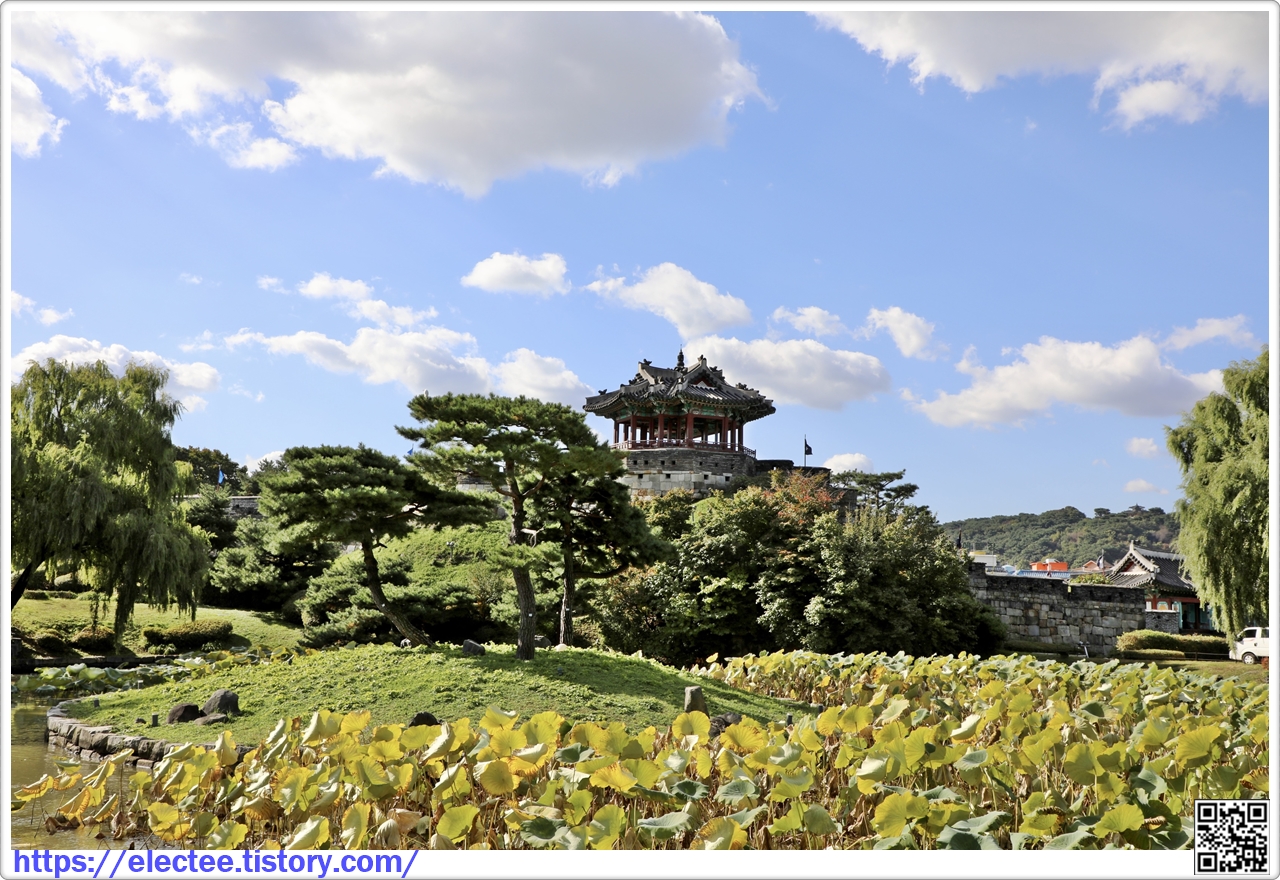
용지와 용두암 이야기
정조 대왕께서 화성을 쌓으면서 방화수류정을 짓기 전 이곳은 수원천이 휘돌아 나가는 제법 깊은 연못이었다.
이곳에는 하늘로 올라가기를 기다리며 천 년 동안 수양을 쌓던 용이 살고 있었다고 한다.
용은 매일 연못으로 놀러 나오는 귀여운 한 소녀를 바라보는 즐거움으로 하루하루를 지내고 있었다.
여러 번 그 소녀를 도와주었지만 소녀는 용의 존재를 몰랐다.
그렇게 세월이 흘러 소녀는 아리따운 여인으로 성장하고 용도 하늘로 오를 날이 가까워지면서 문제가 생겼다.
어느덧 용은 소녀, 아니 성숙해진 여인을 짝사랑하게 된 것이다.
하지만 용과 여인은 서로 다른 존재라서 그들의 사랑은 이루어질 수가 없고,
거거에다 여인은 흔인을 앞두고 있어, 용은 하늘을 다스리는 옥황상제에게 고민을 털어놓았다.
옥 상제는 인간이 되어 여인과 살든지 여인을 잊고 승천을 하든지 둘 중의 하나를 택하라고 했다.
그러나 용은 승천하여 인간들에게 도움을 주는 용이 되는 게 소녀를 위하는 길이라 생각하며 승천을 선택하면서
한 가지 부탁을 하였다. 하루만 인간이 되길 원했던 것이다.
옥황상제는 소원을 들어주며 소녀를 만나게 해 주었으나 헤어진 후 다시는 소녀의 얼굴을 쳐다봐선 안된다고 하였다.
소녀와 만난 후 승천하기를 기다리던 용에게 드디어 그날이 다가왔다.
용은 총만한 하늘의 기운을 온몸에 받으며 공중으로 떠올랐다.
그러나 그도록 연모했던 여인을 아주 잊을 수는 없었던지 잠시 공중에 멈추어 여인이 사는 집을 바라보았다.
아! 우연의 일치인지, 그 순간 여인이 용이 승천하는 하늘 쪽을 바라보고 있었다.
순간 용은 가슴과 온몸이 굳어지며 그대로 땅으로 떨어지고 말았다.
천 년간의 노력이 수포로 돌아가고 말았다.
굳어진 용의 몸은 용연 옆으로 떨어져 내려 언덕이 되었고 머리 부분은 바위가 되었다.
후에 사람들은 이 바위가 용의 머리처럼 생겼다고 해서 용두암으로 부르게 되었고 용이 살던 연못은 용지,
또는 용연이란 이름을 얻게 되었다.
(출처_수원문화원, 수원지명총람)

용이 되기 전 단계의 짐승인 이무기 상

북수문, 화홍문(北水門, 華虹門)
북수문은 화성의 북쪽 성벽이 수원천과 만나는 곳에 설치한 수문이다.
일곱 칸의 홍예문 위로 돌다리를 놓고 그 위에 누각을 지었는데, ‘화홍문’이라는 별칭으로 더 많이 알려져 있다.
누각은 본래 적군의 동태를 살피고 공격할 수 있도록 만든 군사 시설이지만 평소에는 주변 경치를 즐기는
정자로 쓰였다.
수문을 통해 흘러온 물이 물보라를 일으키며 장쾌하게 떨어지는 모습인 ‘화홍관창華虹觀漲’은 화성에서
꼭 보아야 할 아름다운 경치로 손꼽힌다.
화홍문은 조선 헌종 14년(1848)에 수문과 누각을 다시 지으면서 형태가 약간 달라졌다.
1932년에는 ‘수원명소보존회’를 주축으로 수원시민이 힘을 모아 홍수로 무너진 누각을 다시 지었다.
2016년에는 화성성역의궤를 근거로 창문을 복원했다.
* 홍예문 : 윗부분을 무지개 모양으로 반쯤 둥글게 만든 문
Northern Watergate (Hwahongmun Watergate)
The Northern Watergate, also known as Hwahongmun, was built atop Suwoncheon Stream,
the main stream flowing through Hwaseong Fortress.
It has seven stone arches, with the middle arch being wider than the others to emphasize the center
of the entire structure.
On each end of the bridge is an octagonal stone pillar topped with a statue of a mythical,
dragon-like creature called imugi in Korean.
Atop the arches, a stone bridge was built so that people could cross the stream,
and a wooden pavilion was added on the top of the bridge.
This watergate was destroyed by floods and rebuilt several times.
The current structure was built in 1932, and its wooden doors were repaired in 2016.
(안내문)
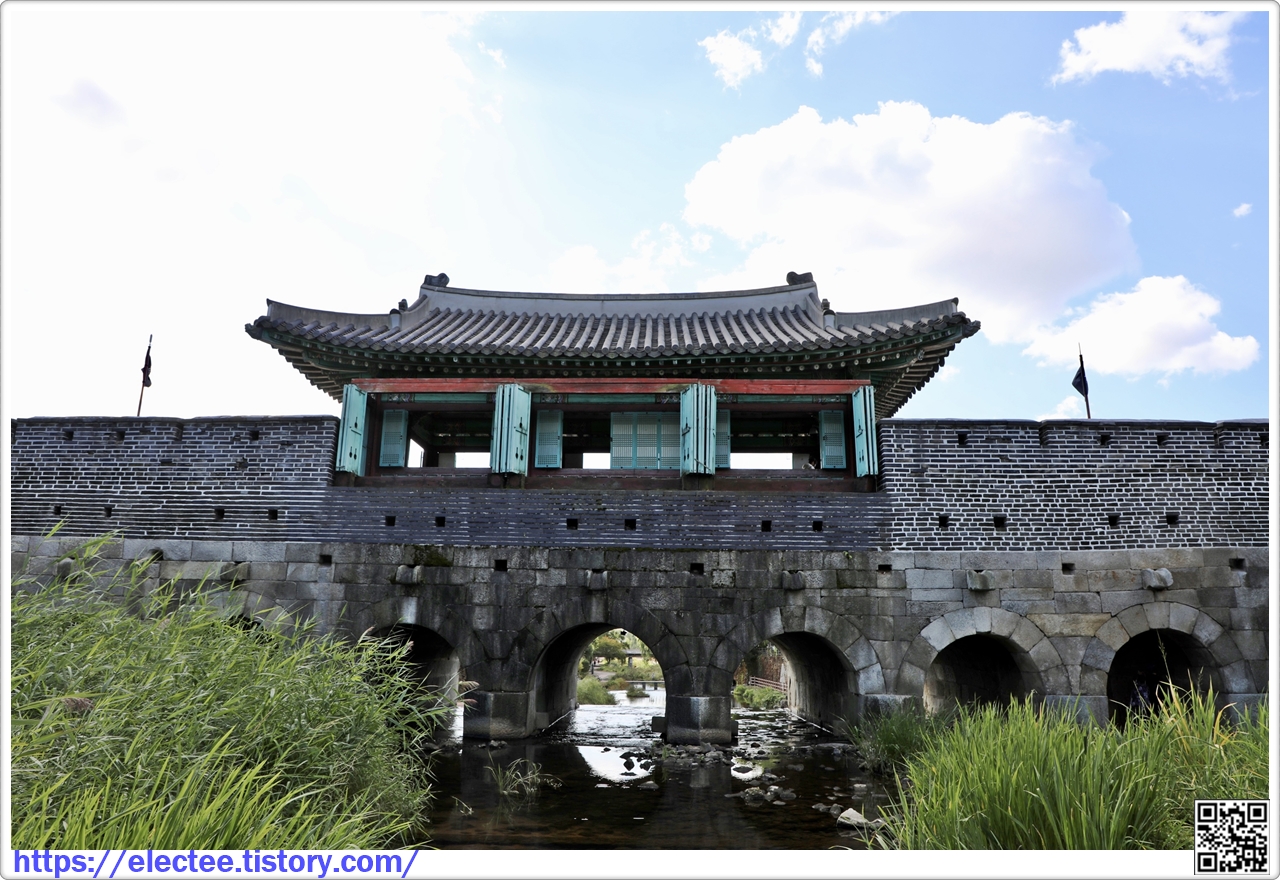
나중에 성 안으로 돌며 찍은 홍화문 전경의 모습을 먼저 올린다.

북동포루 北東砲樓
북동포루는 장안문의 동쪽에 설치한 화포를 갖춘 시설이다.
화성에는 동포류, 서포루 남포루, 북동포로, 북서포루등 5곳의 포로가 있는데 주변 지형 조건에 따라 크기를 달리했다.
포루는 벽돌로 만든 3층 구조로, 아래 두 층은 호포나 좋을 쏠 수 있도록 만들었고,
상층은 군사들이 적을 감시하고 공격할 수 있도록 누각을 만들었다.
정약용은 중국의 제도를 두루 살펴 화성에 발전된 형대의 포르를 설계했는데, 그 모습이 「화성성역의궤」와
「정리의궤」에 그림으로 표현되어 있다.
Northeastern Artillery Pavilion
An artillery pavilion, called poru in Korean, is an outwardly projecting structure topped with a pavilion,
inside which artillery is installed for use in attacking the enemy.
There are five artillery pavilions ir Hwaseong Fortress.
The Northeastern Artillery Pavilion is located in a flat area between the Morthern Watergate
and Northeastern Bastion.
The lower part of its wall was built with stores. The bastion, built of brick, has several arrowslits.
It has three floors, with artillery installed or the bottom floor.
The roof of this artillery pavilion has an uncommon asymmetrical shape.
(안내문)
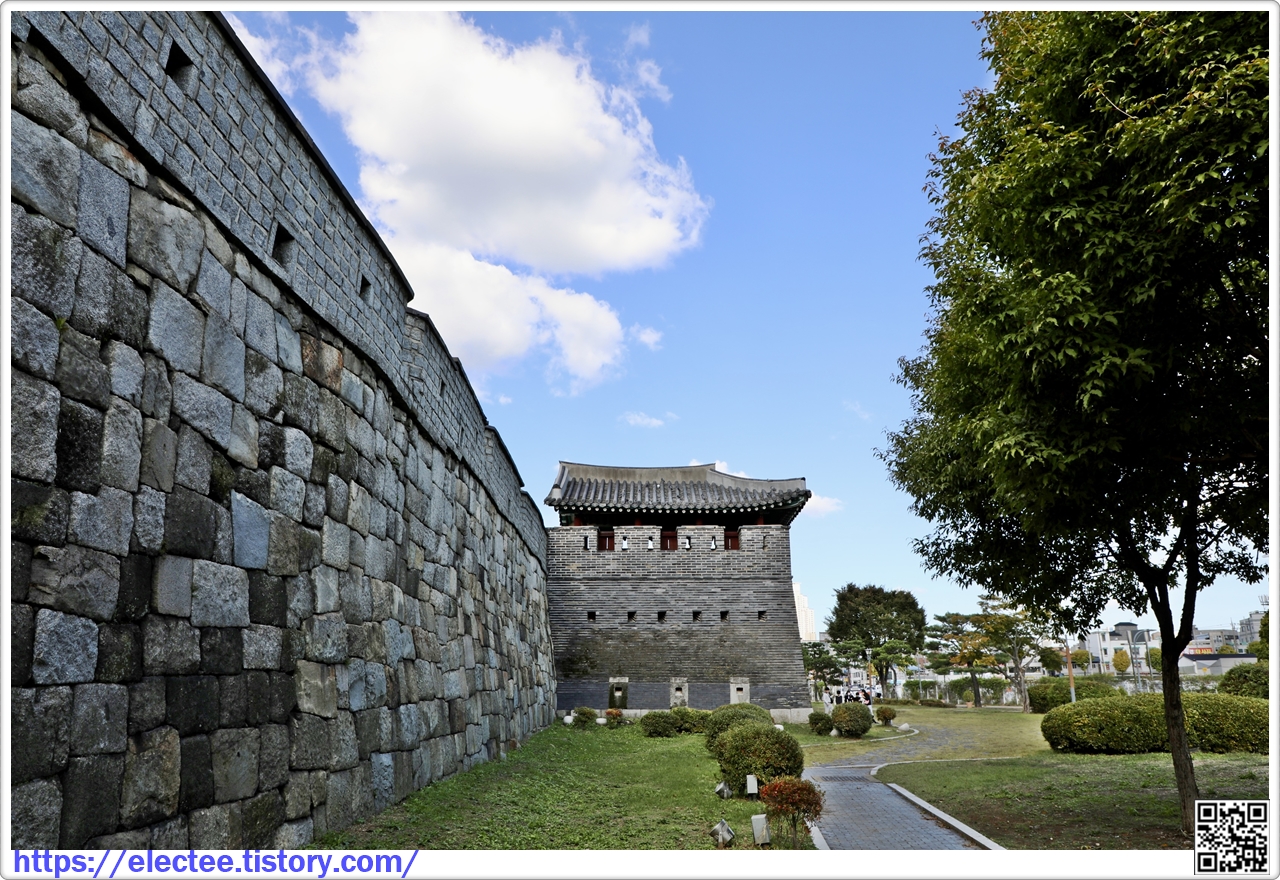
북동치 北東雉
북동치는 장안문 동쪽 북동적대에 붙여서 세운 치성이다.
치성은 성벽의 바깥으로 덧붙여 쌓은 시설로, 성벽 가까이 접근하는 적을 감시하고 공격하는 역할을 했다.
성벽에 8곳, 용도에 2곳의 치성이 설치되어 있는데 지형에 따라 형태가 조금씩 다르다.
북동적대 위치에서 성곽이 급하게 꺾이기 때문에 북쪽을 방어하기 위해 적대에 치를 덧붙였다.
북동치는 장안문을 지키는 중요한 위치이므로 가장 크게 치성을 만들고,
적을 감시하고 공격할 수 있는 총안과 타구'를 설치했다.
1) 타구 : 성벽 위의 낮은 담장인 여장과 여장사이의 열린 부분
Northeastern Bastion
A bastion, called chi in Korean, was a structure projecting outward from a fortress wall,
which was designed to attack approaching enemies from the side.
The name chi comes from the Chinese character for pheasant, because pheasants are good at hiding
and peeping.
Hwaseong Fortress has a total of 10 bastions.
The Northeastern Bastion was built right next to the Northeastern Gate Guard Post.
As the wall at the gate guard post drastically bends to the south, this bastion was added in order to enhance its defense.
This bastion is the largest of all the bastions of Hwaseong Fortress.
It also has battlements so that soldiers could monitor and attack the enemy.
(안내문)
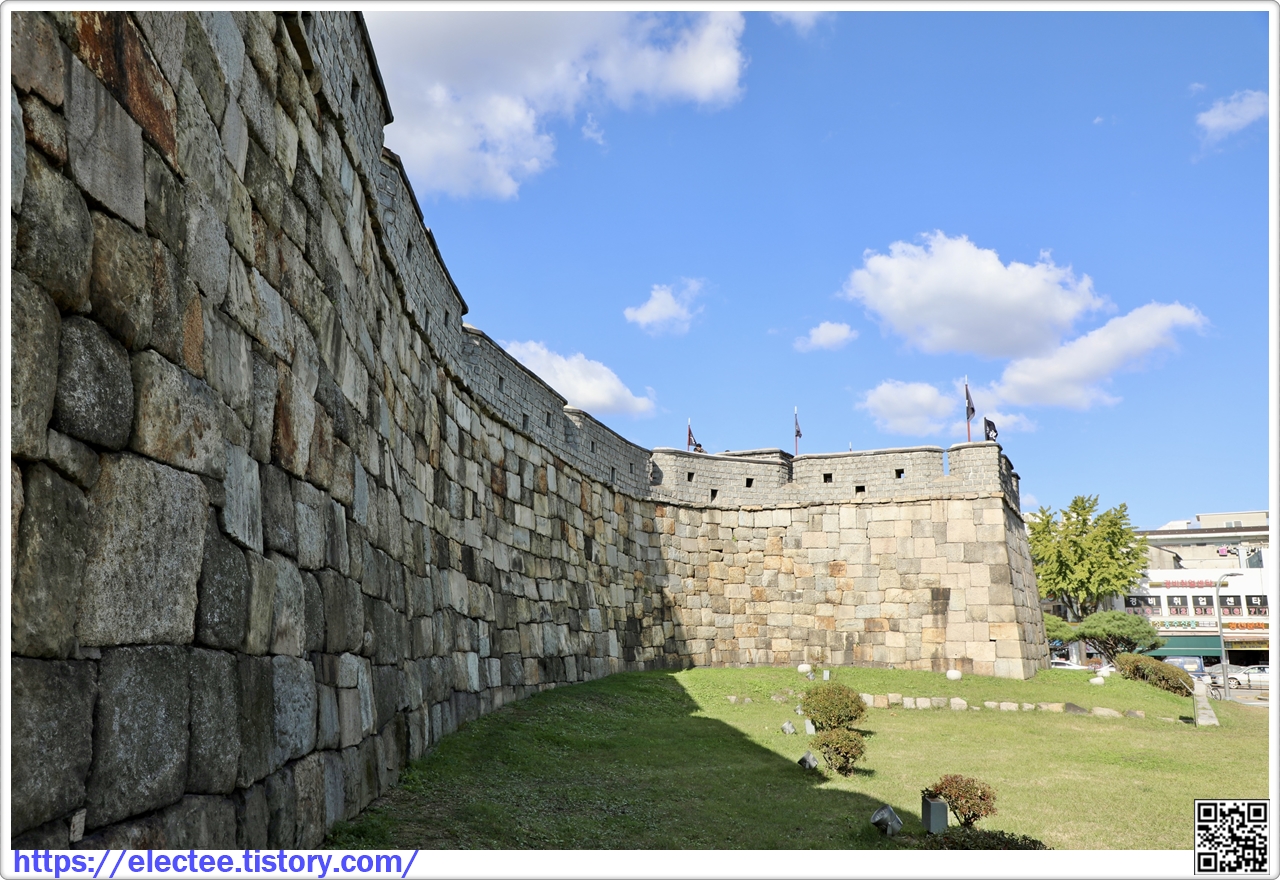
북동적대 北東敵臺
북동적대는 장안문 동쪽에서 성문에 접근하는 적을 감시하고 공격하는 방어 시설이다.
화성에는 장안문과 팔달문 좌우에 적대를 설치했는데 현재 장안문에만 남아 있다.
안쪽은 성벽과 같은 높이로 대를 쌓아 군사들이 지키고, 바깥쪽에는 현안이라고 하는 세로 방향의 긴 홈을 냈다.
현안은 성벽 가까이 접근한 적의 동향을 살피고 동시에 공격도 가능하도록 만든 시설이다.
적대는 우리나라 성곽 중 유일하게 화성에만 있다.
Northeastern Gate Guard Post
A gaie guard post, called jeokdae in Korean,
is a projecting structure built to either side of a fortress gate to monitor the gate and prevent enemy access.
Hwaseong Fortress was the first fortress with such a defensive structure during the Joseon dynasty.
Hwaseong originally had four gate guard posts, two each at Janganmun and Paldalmun Gates,
but only those at Janganmun remain.
As the wall of the Northeastern Gate Guard Post is sharply bent inward,
an additional bastion was installed just to the east of this gate guard post to assist in defense.
The three vertical slits in the middle of the post were designed to attack enemies trying to approach the wall.
(안내문)
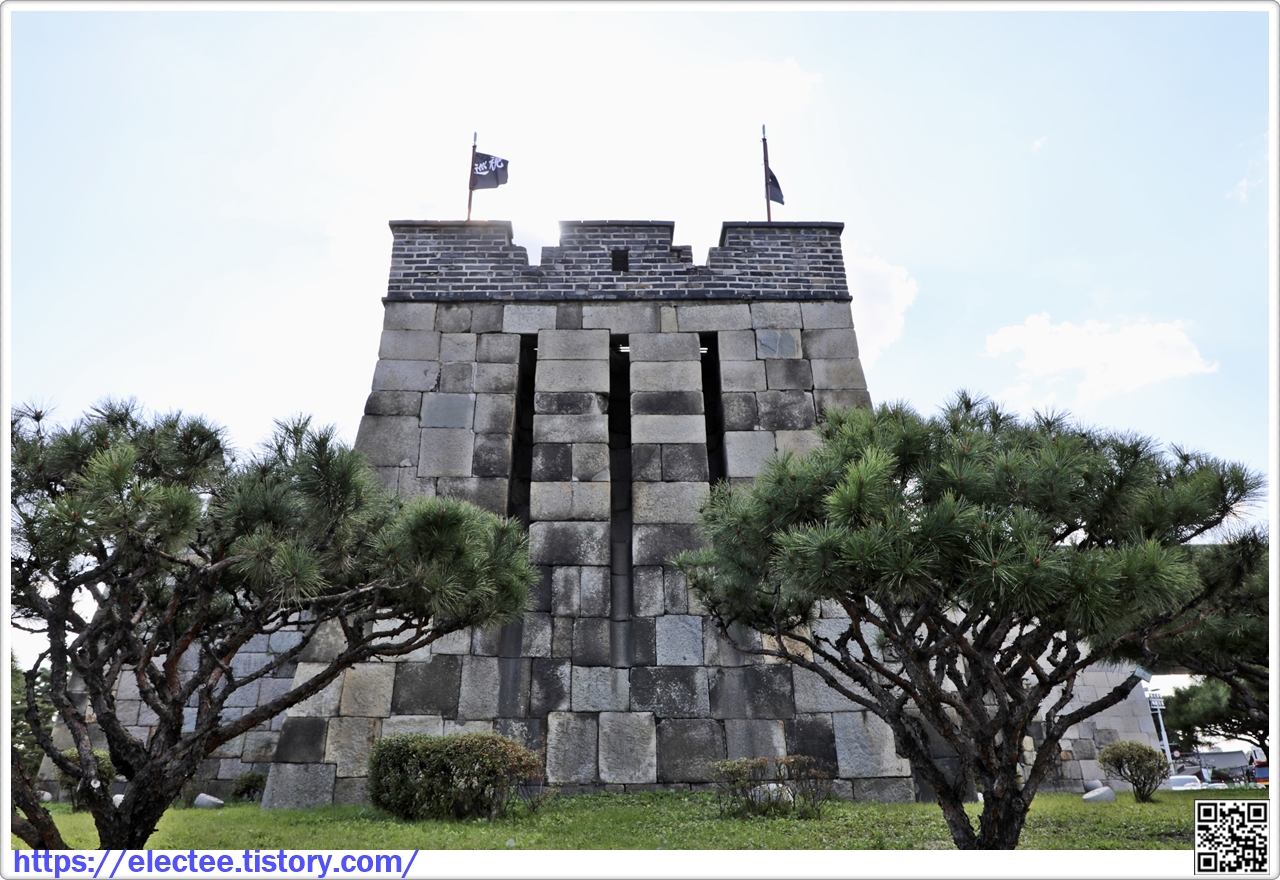
장안문 長安門
장안문은 수원 화성의 북문이다.
정조는 장안부의 의미를 북쪽으로 서울의 궁궐을 바라보고,
"남쪽으로 현륭원(융릉)을 바라보며 만년의 편안함을 길이 알린다"라고 풀이했다.
문 밖에 항아리 모양의 옹성을 만들고 방어를 위해 좌우에 적대를 세웠다.
장안문은 남문인 팔달문과 더불어 화성에서 가장 웅장하고 높은 격식을 갖춘 건물이다.
2층의 누각은 네 모서리 추녀가 길게 경사를 이루면서 용마루와 만나는 우진각 지붕 형태다.
길고 휘어진 목재를 구하기 힘든 조선 시대에 우진각 지붕은 궁궐이나 도성의 정문과 같은 건물에만 쓰였다.
문루 처마 밑에는 다포라는 화려하고 정교하게 다듬은 받침 목재를 짜 맞췄는데,
다포식 건물은 18세기 이후 궁궐에서도 거의 백 년 동안 짓지 않았기 때문에 특별히 강원도 출신의 승려 목수인
굉흡이 와서 건설을 도왔다.
서울의 숭례문, 홍인지문과 함께 조선 시대 성문을 대표하던 장안문은 한국 전쟁 때 폭격으로 파괴되어
1975년에 다시 복원하였다. 석축에 총탄 자국이 남아 있다.
- 옹성 : 성을 지키기 위하여 성문 밖에 쌓은 작은 성
- 용마루 : 지붕 가운데 부분에 있는 가장 높은 수평 마루
Janganmun is the north gate of Hwaseong Fortress. Its name "Jangan" means "perpetual peace."
One of the four gates of Hwaseong Fortress, Janganmun was constructed in 1794.
It consists of a stone arch, twostory wooden pavilion, and a semi-circular brick wall which helps defend the gate.
As the main thoroughfare of Hwaseong was along a north-south axis, the north and south gates played
a comparatively more important role as the main entrance and exit of the fortress.
Typically, the main gate of a traditional Korean fortress was the south gate. However,
as King Jeongjo would first come upon the north gate when travel ling to Hwaseong from the capital,
Hwaseong Fortress's north gate is its main gate.
The wooden pavilion of this gate was destroyed during the Korean War (1950-1953) and was reconstructed in 1975.
(안내문)
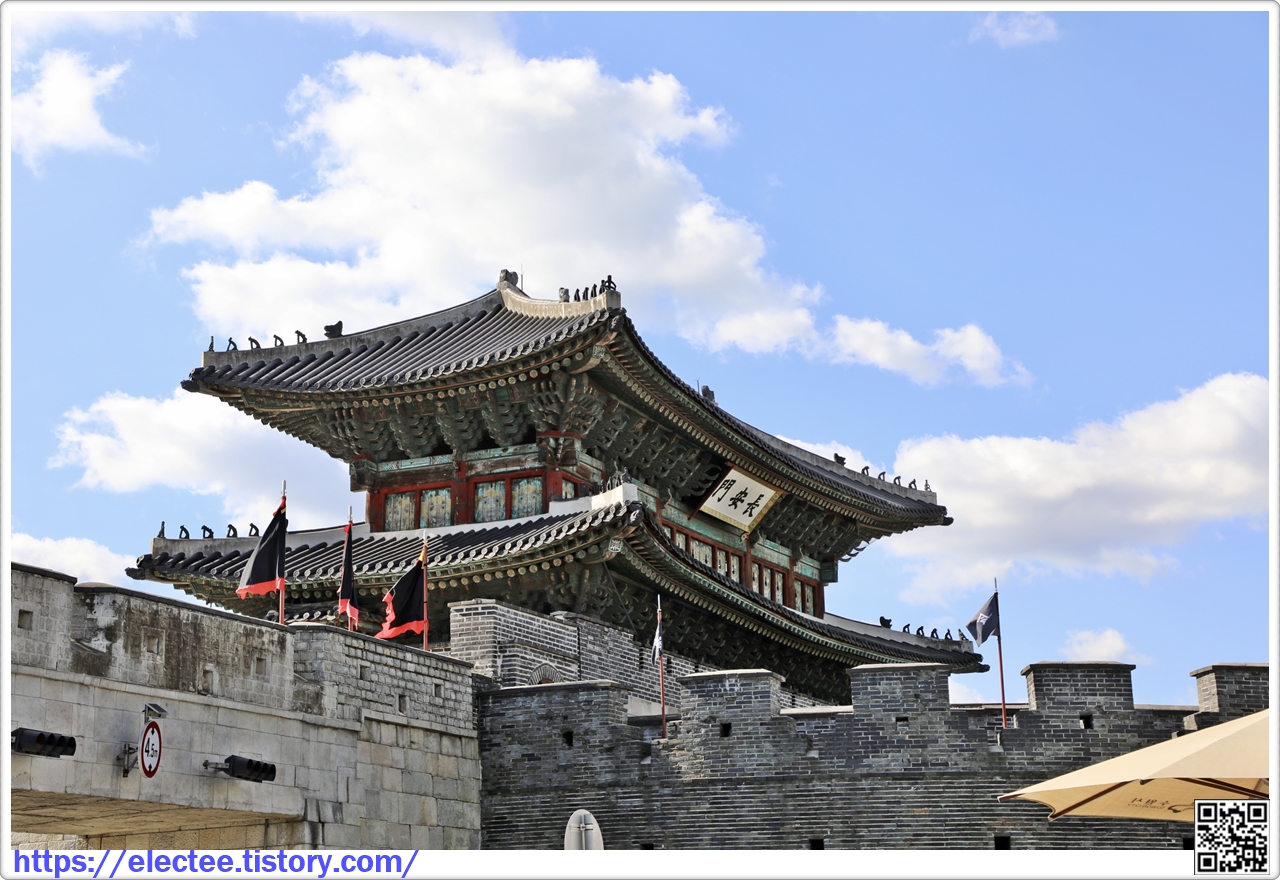
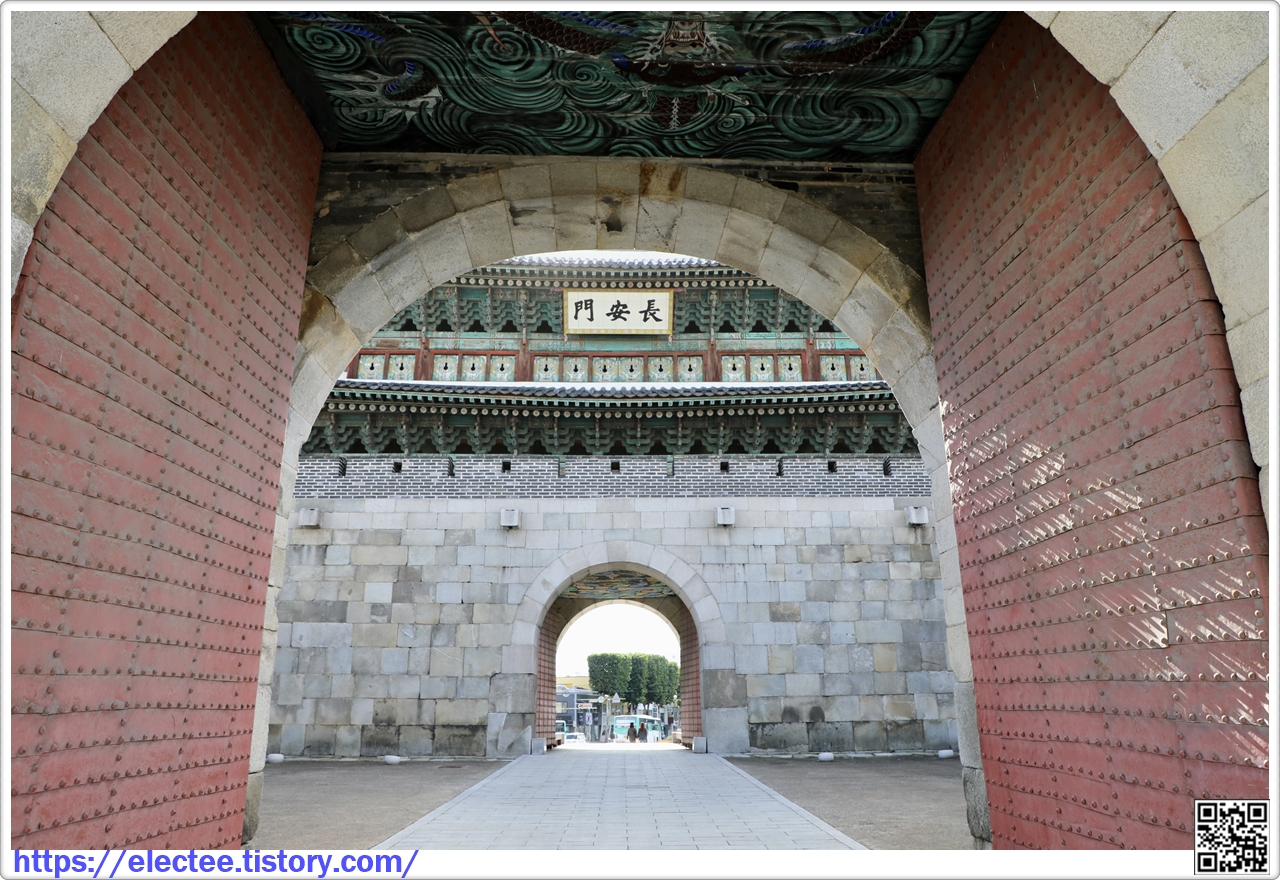
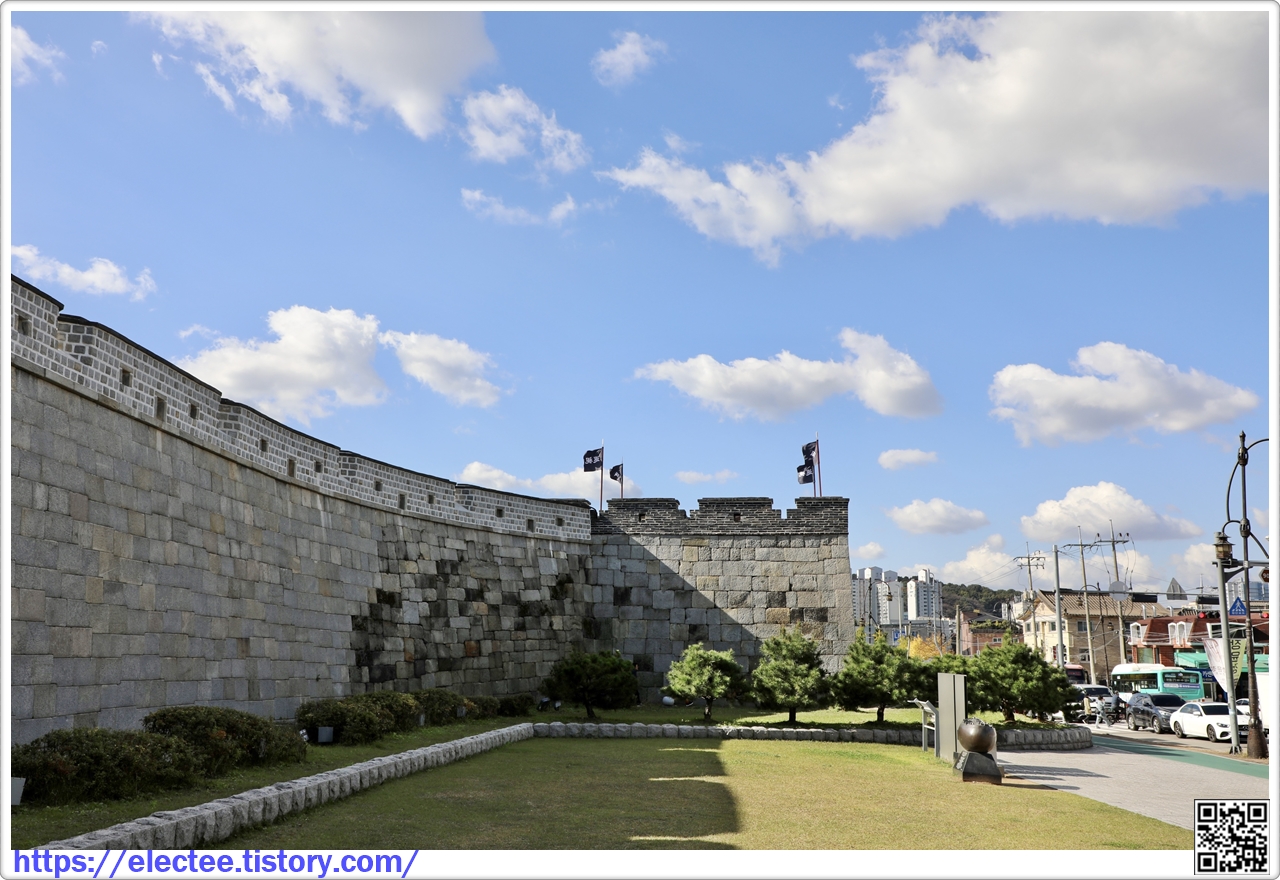
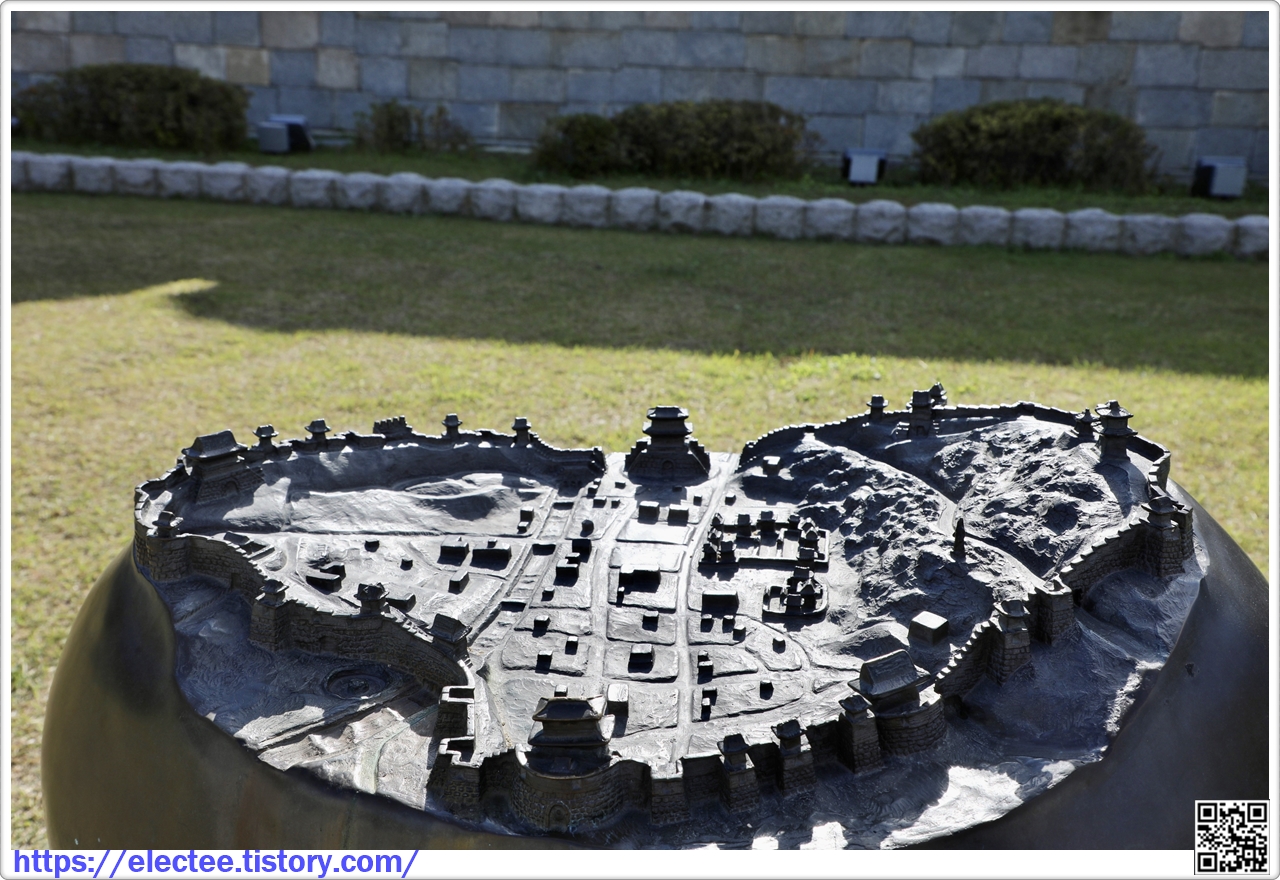
평지 북성 平地 北城
평지 북성은 화성을 축성하면서 네 구간으로 나눈 성벽 가운데 평지로 이루어진 북쪽 성곽이다.
북문인 장안문을 중심으로 동쪽은 북동적대부터 북수문(화홍문)까지,
서쪽은 북서적대부터 서북공심돈까지 모두 10개 시설물이 있다.
이 일대는 지형이 평탄한 편이어서 방어에 유리하도록 다른 곳보다 성벽을 높게 쌓았다.
장안문 주변은 성벽이 약간 바깥으로 나온 편이다.
이는 처음에 화성의 성벽 위치를 결정할 때 민가가 밀집해 있는 지역을 피하고,
남문과 북문의 거리를 확보하라는 정조의 뜻을 반영하였기 때문이다.
북성 구간에서 눈여겨볼 곳은 성문 양쪽에 적대를 세운 장안문, 수원천과 누각이 조화를 이룬 화홍문,
빼어난 군사 시설인 서북공심돈을 들 수 있다.
Northern Section of Hwaseong Fortress
The northern section of Hwaseong Fortress is centered around the north gate, Janganmun.
It includes a total of 10 structures - from the Northeastern Gate Guard Post to the Northern Watergate
(Hwahongmun) to the east and from the Northwestern Gate Guard Post
to the Northwestern Watchtower to the west.
The construction of Hwaseong Fortress was carried out in four sections,
and this northern section was the first to be constructed.
The land in this area is flat, and the walls in this section are the tallest in the fortress.
When King Jeongjo was surveying this area before the fortress was built,
he saw that if built according to plan, the fortress walls would run straight through an area with many homes.
Therefore, he ordered the north gate, Janganmun, and the adjacent northern section to project further
outward than planned to avoid demolishing the existing houses in the area.
(안내문)
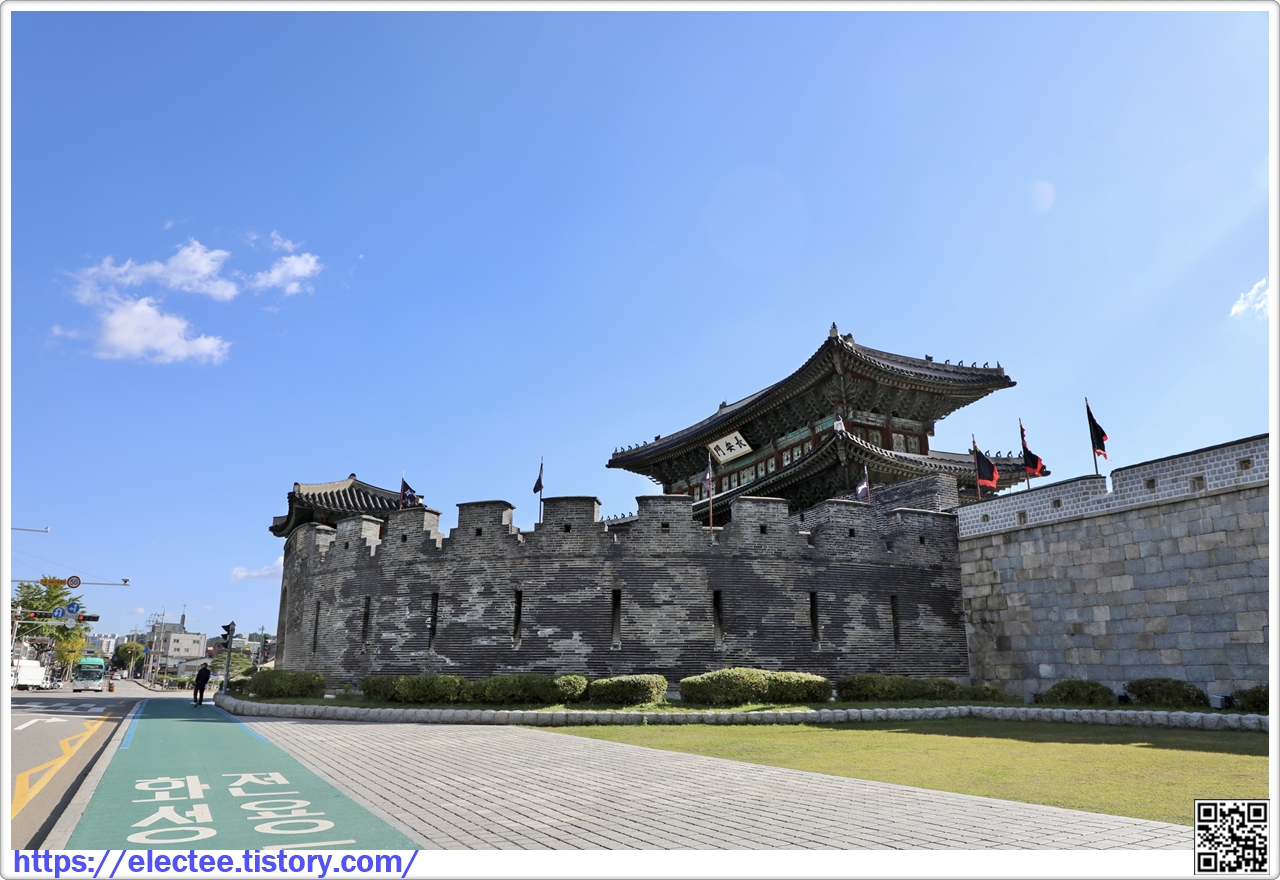
북서적대 北西敵臺
북서적대는 장안문 서쪽에서 성문에 접근하는 적을 감시하고 공격하는 방어 시설이다.
화성에는 장안문과 팔달문 좌우에 적대를 설치했는데 현재 장안문에만 남아 있다.
장안문 좌우 적대에는 "현안" 세 줄을 설치한 반면 팔달문 적대에는 두 줄을 설치했다.
현안은 성벽 가까이 접근한 적의 동향을 살피고 동시에 공격도 가능하도록 만든 시설이다.
적대는 우리나라 성곽 중 유일하게 화성에만 있다.
1) 현안 : 성벽의 바깥에 위에서 아래로 낸 홈
Northwestern Gate Guard Post
A gate guard post, called jeokdae in Korean, is a projecting structure built to either side of a fortress gate
to monitor the gate and prevent enemy access.
Hwaseong Fortress was the first fortress with such a defensive structure during the Joseon dynasty.
Hwaseong originally had four gate guard posts, two each at Janganmun and Paldalmun Gates,
but only those at Janganmun remain.
The three vertical slits in the middle of the Northwestern Gate Guard Post were designed to
attack enemies trying to approach the wall.
(안내문)

북쪽 지역은 평지라 성을 좀 더 높게 쌓았다.
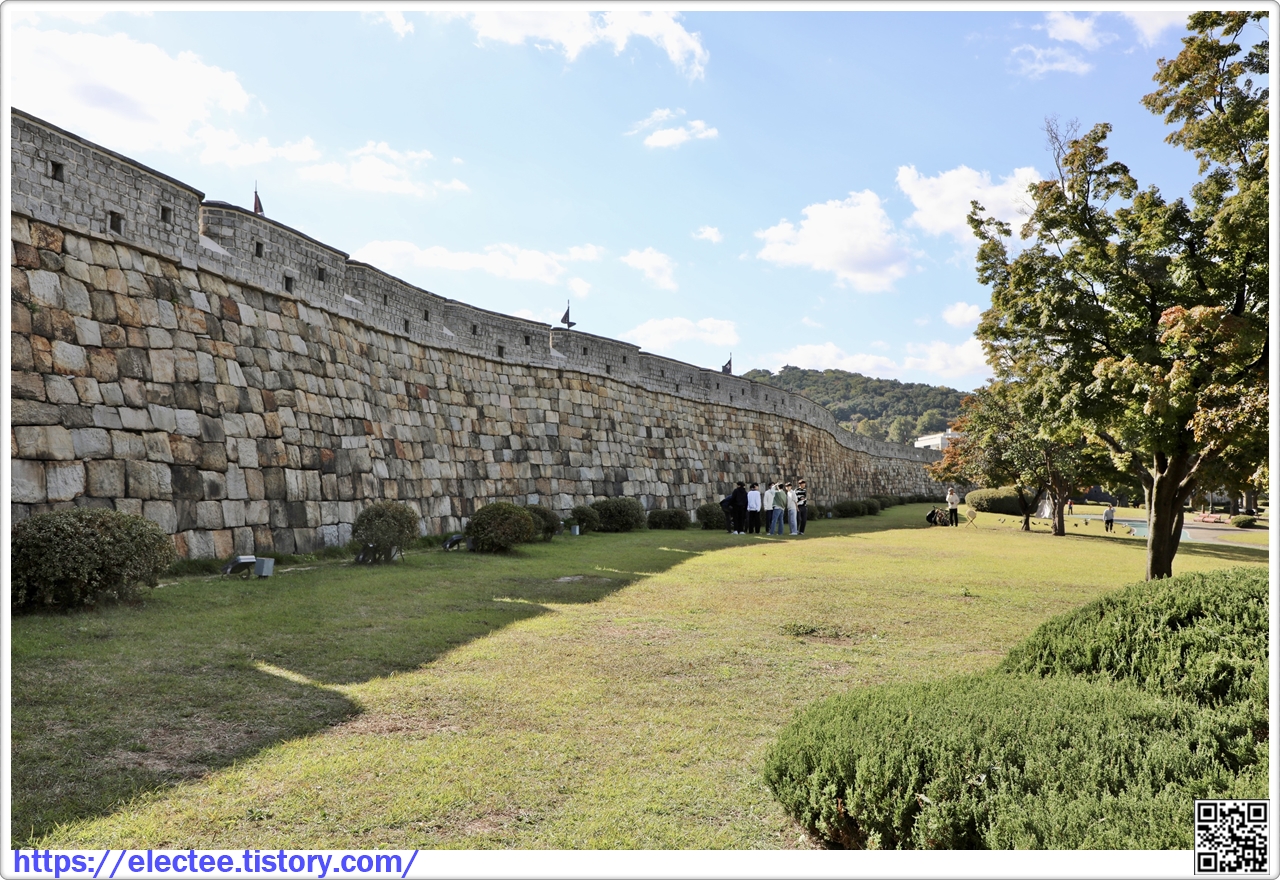
이번 치성의 안내문은 생략한다.

숙종 때 북한산성 등 많은 성을 쌓았는데, 정조 때 쌓은 수원화성이 가장 정교하고 아름답다.

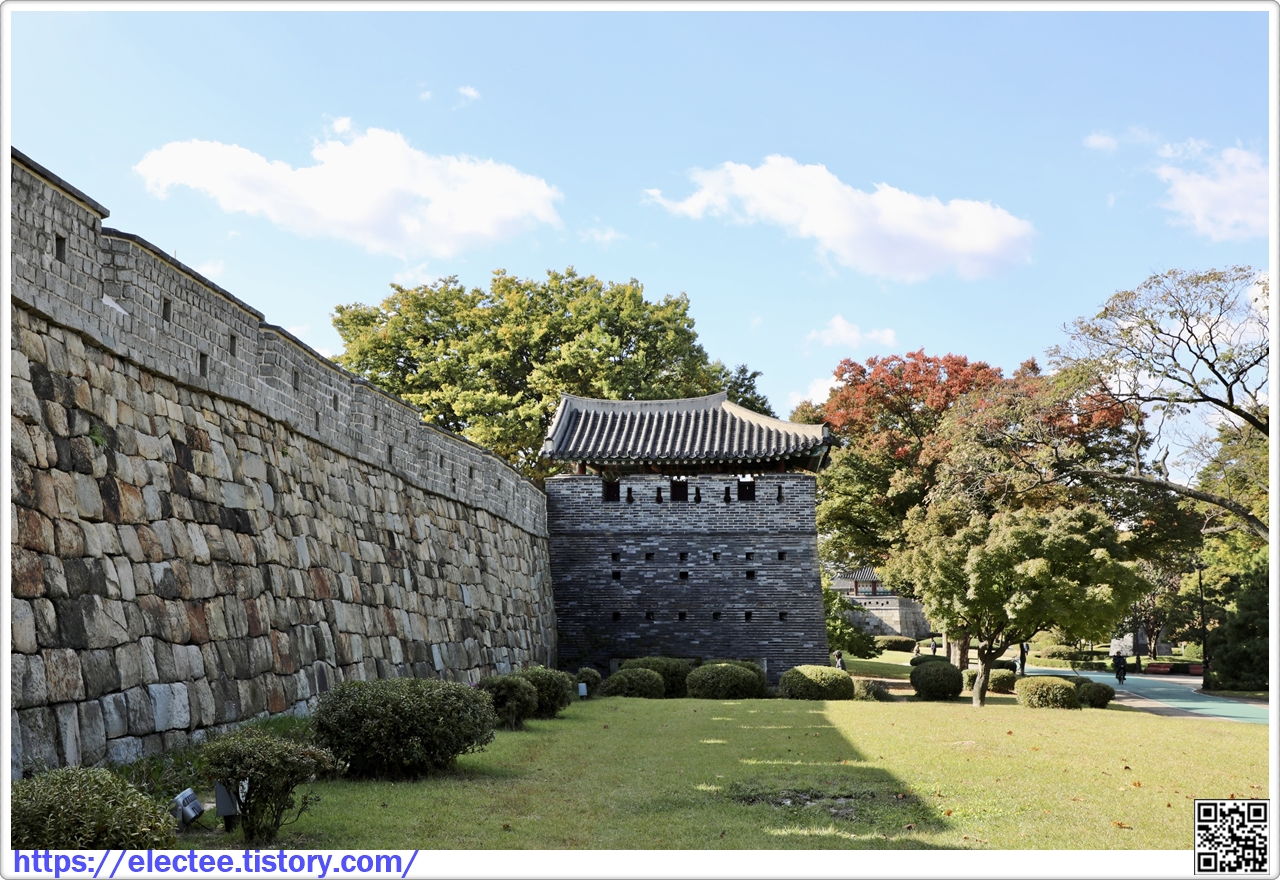
북서포루 北西砲樓
북서포루는 장안문 서쪽에 설치한 화포를 갖춘 시설이다.
화성에는 동포루, 서포루, 남포루, 북동포루, 북서포루 등 5곳의 포루가 있는데, 주변 지형 조전에 따라 크기를 달리했다.
이 중 평탄한 곳에 지은 북서포루가 가장 높다.
포루는 벽돌로 만든 3층 구조로 아래 두 층은 화포나 총을 쏠 수 있도록 만들었고,
상층은 군사들이 적을 감시하고 공격할 수 있도록 누각을 만들었다. 부서포루와 북동포루는 안팎의 지봉 형태가 다르다.
이는 「화성성역의궤」에 수록되어 있는 각 시설물 자재 목록을 바탕으로 복원된 것이다.
Northwestern Artillery Pavilion
An artillery pavilion, called poru in Korean, is an outwardly projecting structure topped with a pavilion,
inside which artillerv is installed for use attacking the enemy There are five artillery pavilions in Hwaseong Fortress.
The Northwestern Artillery Pavilion is located between,
the Northwestern Gate Guard Post and the Northern Guard Pavilion.
It is the tallest among the artillery pavilions of Hwaseong Fortress.
The roof of this artillery pavilion has an uncommon asymmetrical shape.
(안내문)

이번 편에도 포루의 사용 안내도를 올리니 참고하시길 바란다.
잠시 후 마주하게 될 서북공심돈과 같이 이해해도 좋다.
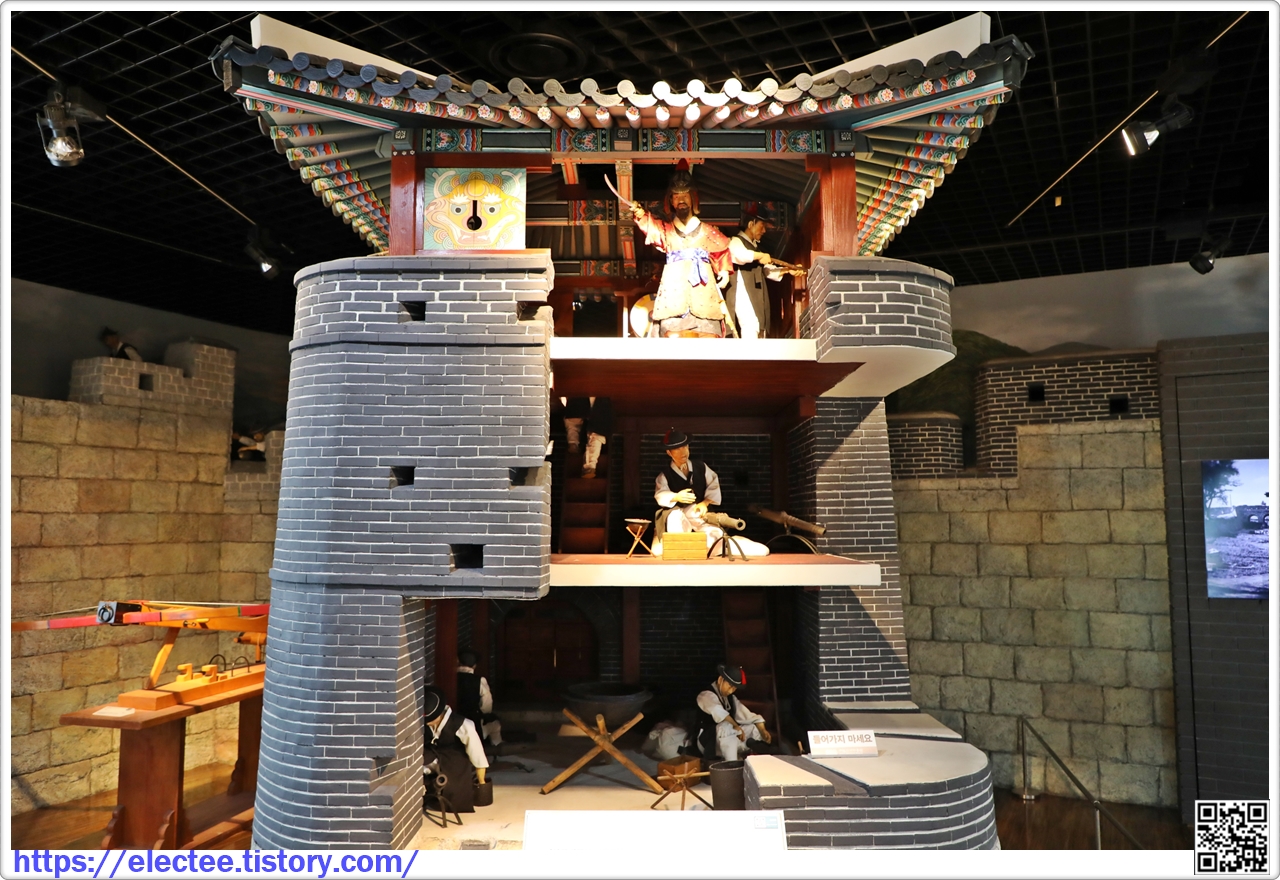
북포루 北砲樓
북포루는 북서포루와 서북공심돈 사이에 있는 치성 위에 군사들이 머물 수 있도록 누각을 지은 시설이다.
치성은 성벽 일부를 돌출시켜 적을 감시하고 공격할 수 있도록 만든 시설물이다.
화성에는 모두 15곳의 치성이 있는데 그중 중요한 5곳의 지성 위에 동1포루, 동2포루, 서포구, 북포루,
동북포루를 만들고 적의 동향을 감시했다.
북포루는 화성에서 가장 평탄하고 시아가 트인 곳에 있어서 주둔하는 군사의 수도 많고 규모도 크다.
'군포로'라고도 불렀다.
Northern Guard Pavilion
A guard pavilion, called poru in Korean, is an outwardly projecting structure topped
with a pavilion that functioned as a soldiers' lookout.
There are five guard pavilions in Hwaseong Fortress.
The Northern Guard Pavilion, built between the Northwestern Artillery Pavilion and the Northwestern Watchtower,
is the largest of the guard pavilions in Hwaseong Fortress.
The structures in the northern section of this fortress are large in comparison to those of other sections,
because its surroundings were wide and open, and a larger number of soldiers were required to stay in this area.
(안내문)

이 서북공심돈의 아래에 있는 치성은 살짝 균열이 생기며 벌어졌다
치성 위의 공심돈 무게에 쏠리며 벌어진 것으로 보이는 데, 추후 복원이 만만치 않겠다.
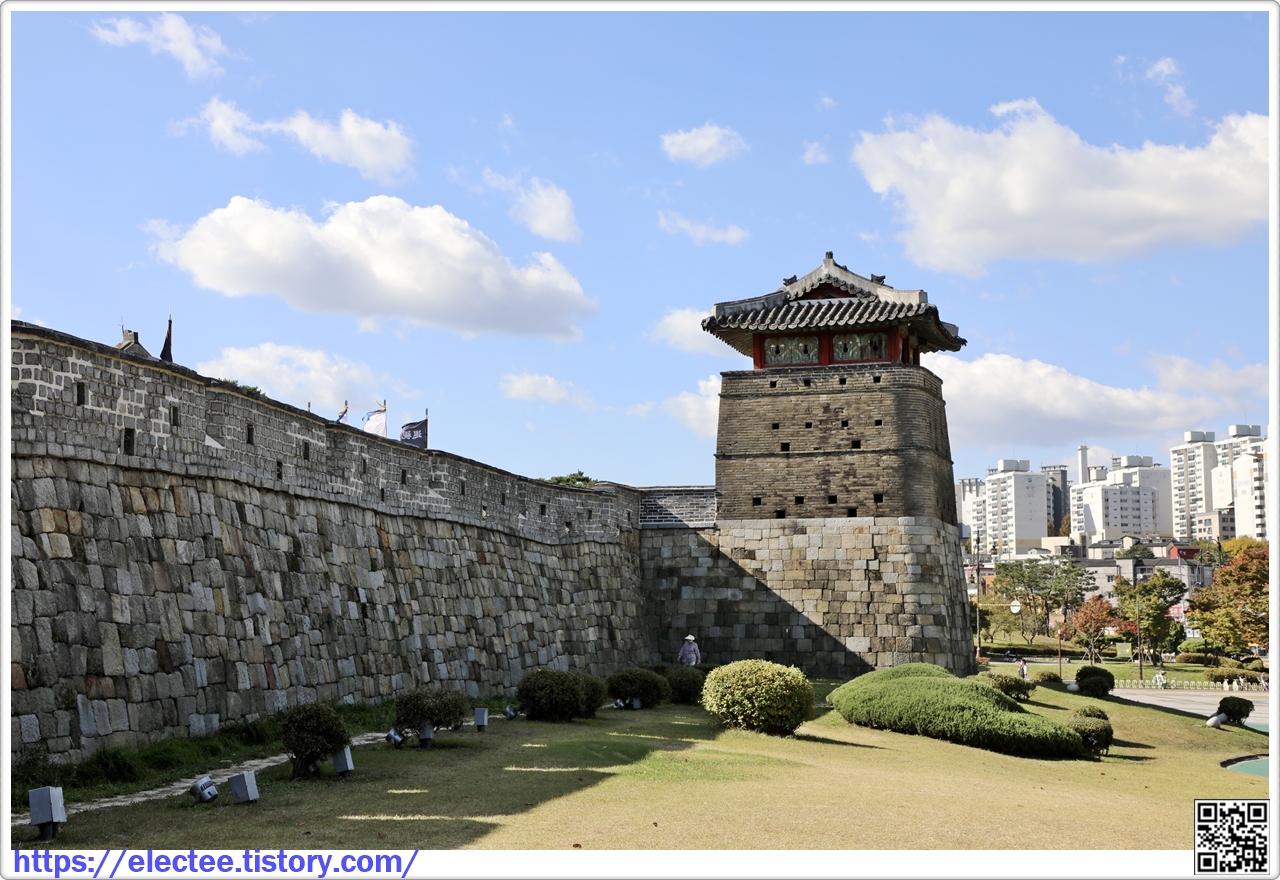
서북공심돈 西北空心墩
서북공심돈은 화성 서북쪽에 세운 망루로 주변을 감시하고 공격하는 시설이다.
공심돈은 속이 빈 돈대라는 뜻으로, 우리나라 성곽 중 화성에서만 볼 수 있다.
보통 돈대했는 성곽과 떨어진 높은 곳에 세워 적을 감시하는 시설이나,
서북공심돈은 서북쪽 성벽이 꺾이는 위치에 설치했다.
"치성" 위에 벽돌로 3층의 망루를 세우고 꼭대기에는 단층의 누각을 올려 군사들이 감시할 수 있도록 하고,
외벽에는 화포를 쏠 수 있는 구멍을 뚫어 공격 기능까지 갖추었다.
조선 정조 21년(791) 정월, 완성된 화성을 둘러보던 정조는 서북공심돈 앞에 멈춰
"우리나라 성곽에서 처음 지은 것이니 마음껏 구경하라." 며 매우 만족스러워했다.
화성에는 모두 세 곳에 공심돈을 세웠는데 서북공심돈만이 축성 당시 모습 그대로 남아 있다.
1) 치성 : 성벽 일부를 돌출시켜 적을 감시하고 공격할 수 있도록 만든 시설
Northwestern Watchtower
This is a watchtower for monitoring the surroundings and attacking enemies.
Its Korean name, gongsimdon, means "hollow outpost." This is because a gongsimdon conventionally has no
facilities in its tall brick tower apart from an inner staircase and arrowslits in the walls.
In Korea, this kind of watchtower was only constructed in Hwaseong Fortress.
There were originally three watchtowers in Hwaseong Fortress, but only two remain today.
The Northwestern Watchtower is located next to Hwaseomun Gate and has maintained
its original structure built in 1796.
It consists of three floors and is topped with a pavilion.
When King Jeongjo visited Hwaseong Fortress the year after it was completed, he was greatly satisfied
with this watchtower and emphasized how it was the first of its kind to be built in a Joseon fortress.
(안내문)
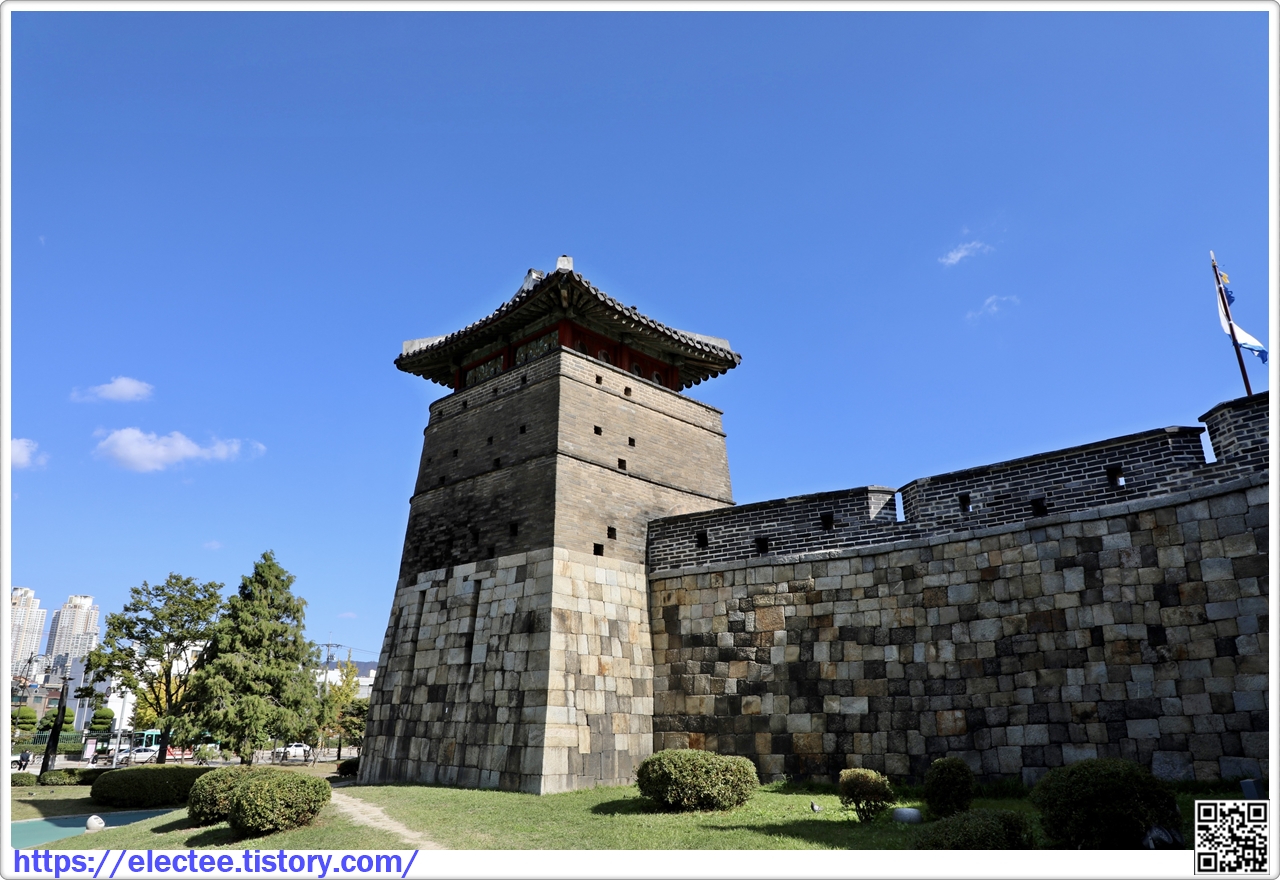
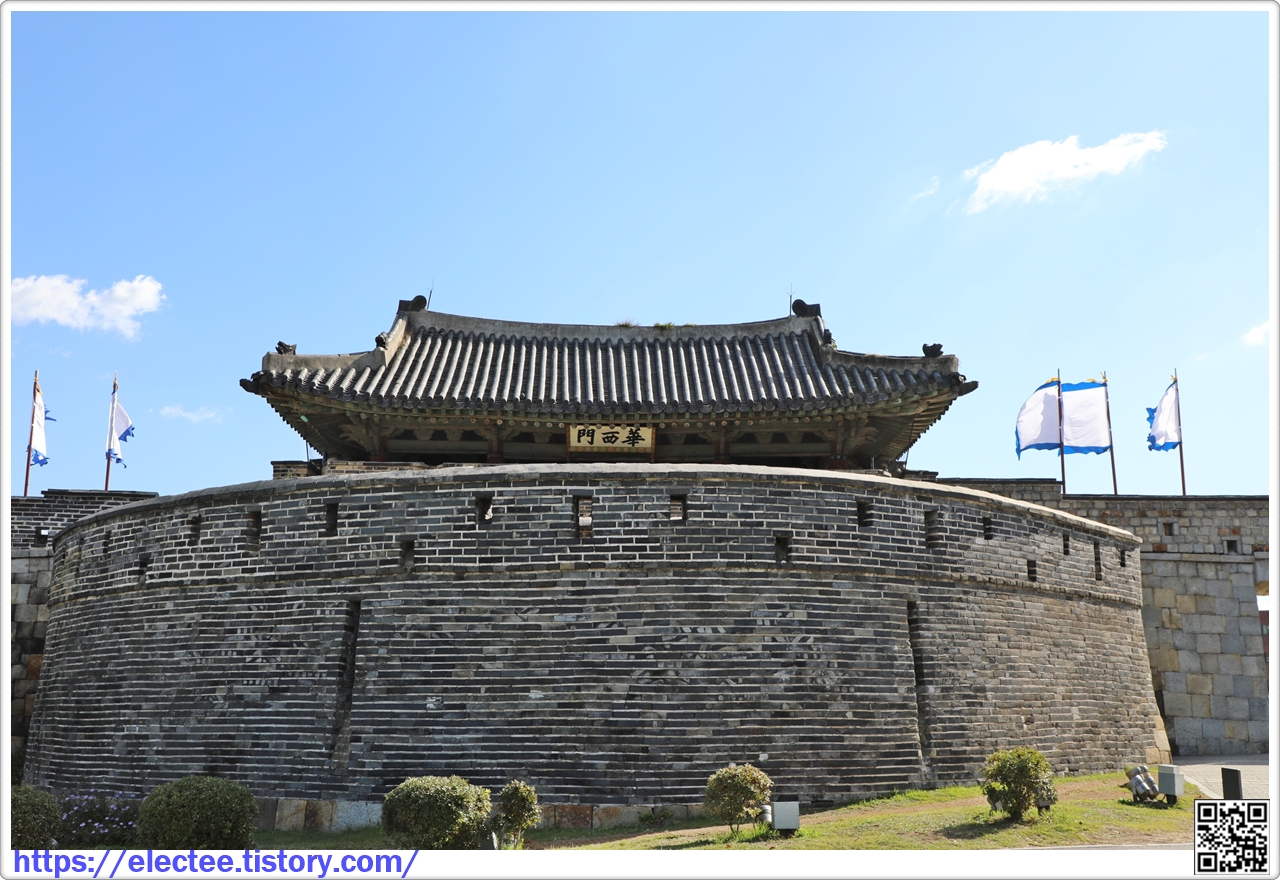
화서문 華西門
보물 제403호, 1796년(정조 20) 창건, 1848년(헌종 14) 수리, 1975년 수리
화서문은 수원 화성의 서문이다. ‘화성의 서쪽’이란 뜻이지만 서쪽에는 팔달산이 있어 서북쪽에 문을 두었다.
문밖으로 넓은 평지가 펼쳐져 있어 주변을 감시하기 위해 높다란 서북공심돈을 함께 세웠다.
조선 시대 건축에는 일정한 위계질서가 있다.
같은 성문이지만 장안문과 팔달문은 높은 격식을 갖춘 반면 창룡문과 화서문은 한 단계 격을 낮춘 형태이다.
석축의 규모도 작고, 1층 문루에 팔작지붕으로 이루어졌다.
화서문은 창건 당시 모습을 잘 유지하고 있어 간결하면서도 섬세한 18세기 건축 기술을 보여준다.
옹성 안 석축에는 공사를 담당한 감독관과 우두머리 석공의 이름이 새겨져 있다.
서울과 개성, 강화도에서 온 석공이 참여했는데 박상길은 축성이 끝난 후 석공 가운데 가장 높은 등급의 상을 받았다.
현판은 화성 축성의 총책임자였던 채제공이 썼으나 원본이 남아 있지 않다.
Hwaseomun Gate
Hwaseomun is the west gate of Hwaseong Fortress.
“Hwaseo (華)” literally means “the west of Hwaseong Fortress,” however, the gate is actually located
at the northwest of the fortress, because at due west of the fortress is the summit of Paldalsan Mountain.
One of the four gates of Hwaseong Fortress, Hwaseomun was constructed in 1796.
It consists of a stone arch,
single-story wooden pavilion, and a semi-ircular brick wall which helps defend the gate.
The names of those involved in the construction are inscribed on the stone wall of the gate.
Hwaseomun was comparatively well-reserved and was therefore designated as Treasure No. 403 in 1964.
The wooden pavilion and stone arch underwent minor repairs in 1975.
Hwaseomun, when viewed together with the adjacent Northwestern Watchtower,
is considered one of the most iconic scenes of Hwaseong Fortress.
(안내문)
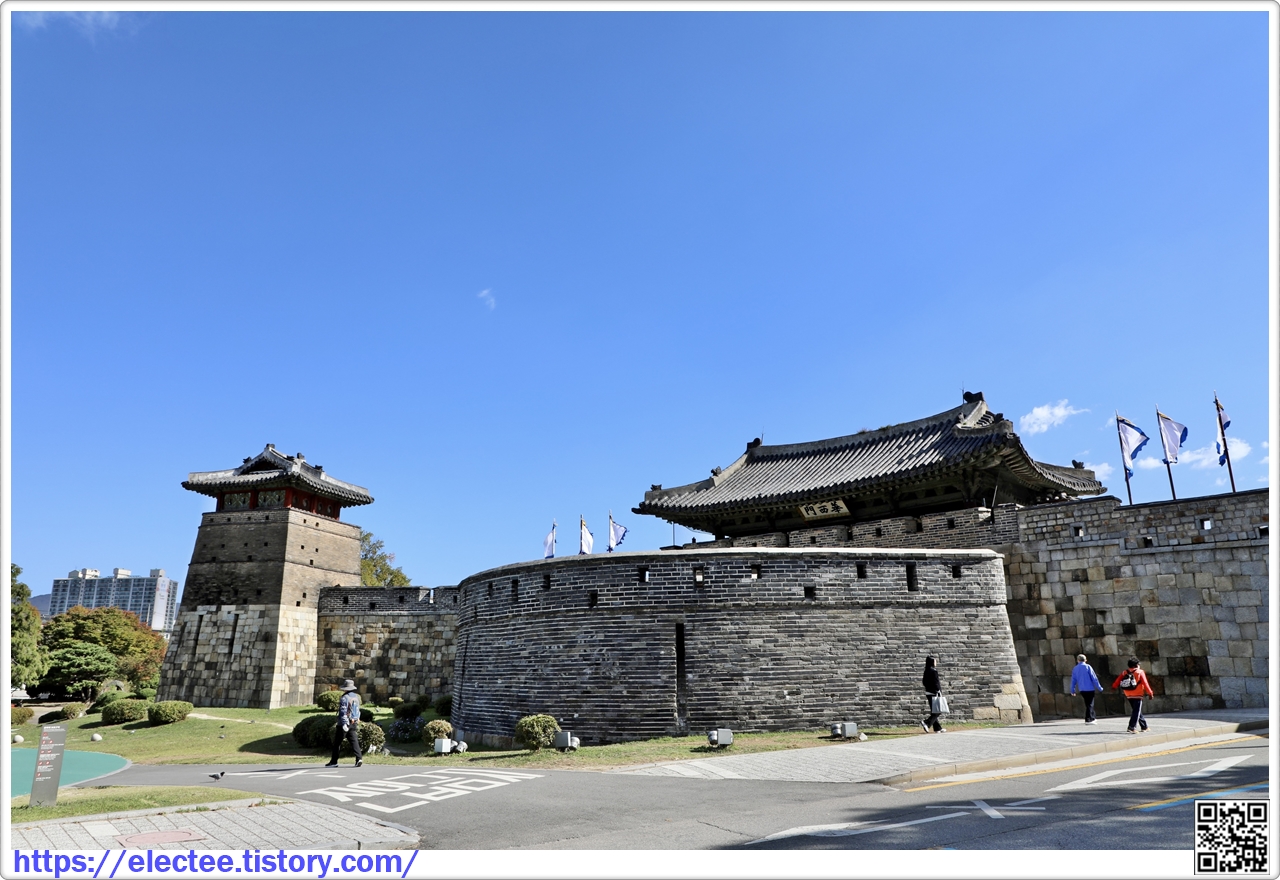
서북각루 西北角樓
서북각루는 화성 서북쪽 요충지에 세운 감시용 시설이다. 화성에는 모두 4곳의 각루가 있다.
서북가루는 팔달산으로 오르는 경사지에서 성벽이 휘어진 곳에 자리 잡아 서북쪽 일대가 한눈에 들어온다.
아래층에는 군사들이 머무는 방에 온돌을 놓았고 위층은 마룻바닥으로 만들었다.
지금은 사라졌지만 사면에 널빤지 문을 달고 구멍을 내서 적을 감시했다.
Northwestern Corner Pavilion
A corner pavilion, called gangnu in Korean, was built on the high ground of the fortress to watch
the surrounding area and to be used for leisure.
The name comes from the fact that there is one such pavilion at each of the four corners of Hwaseong Fortress.
The Northwestern Corner Pavilion, located on the western side of Hwaseomun Gate, commands a panoramic
view of the areas to the north and west of the fortress.
The pavilion also includes a small room for soldiers with a traditional Korean under-floor heating system called ondol.
(안내문)
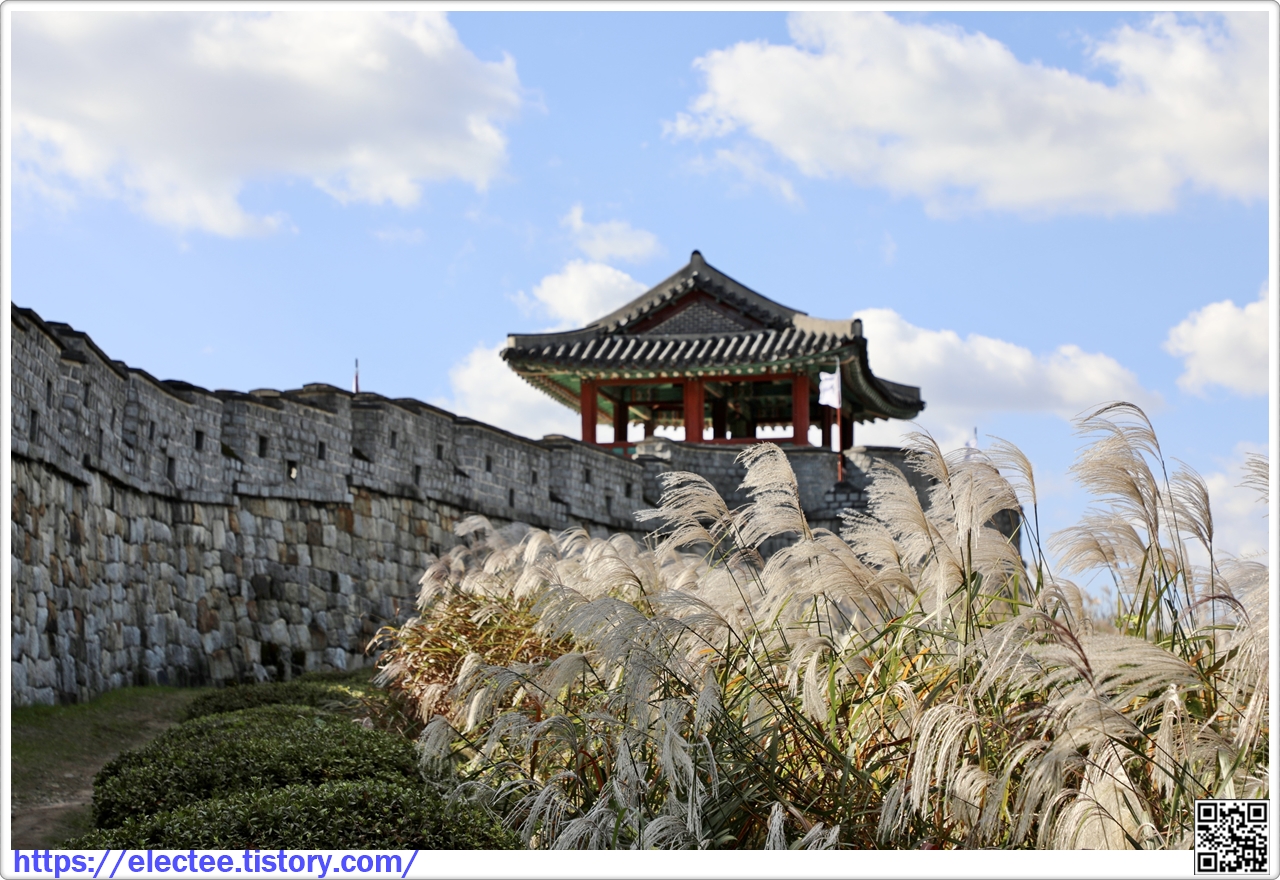
서북각루부터 서1치 구간은 오전에 수원화성 순성을 시작할 때 본 곳이다.
그때는 응달이라 어두웠는데, 지금이 해가 구름에 가렸어도 억새의 물결이 아름답다.
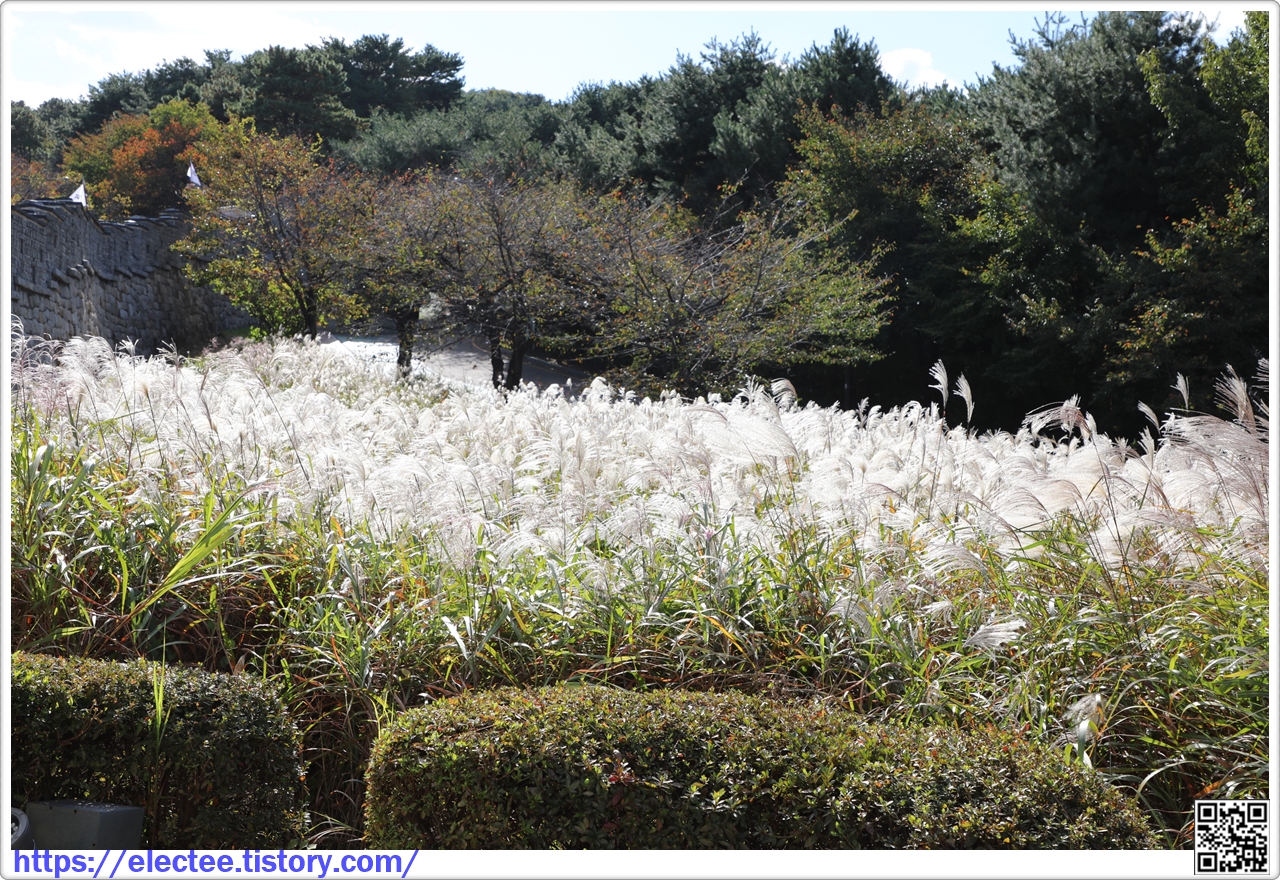
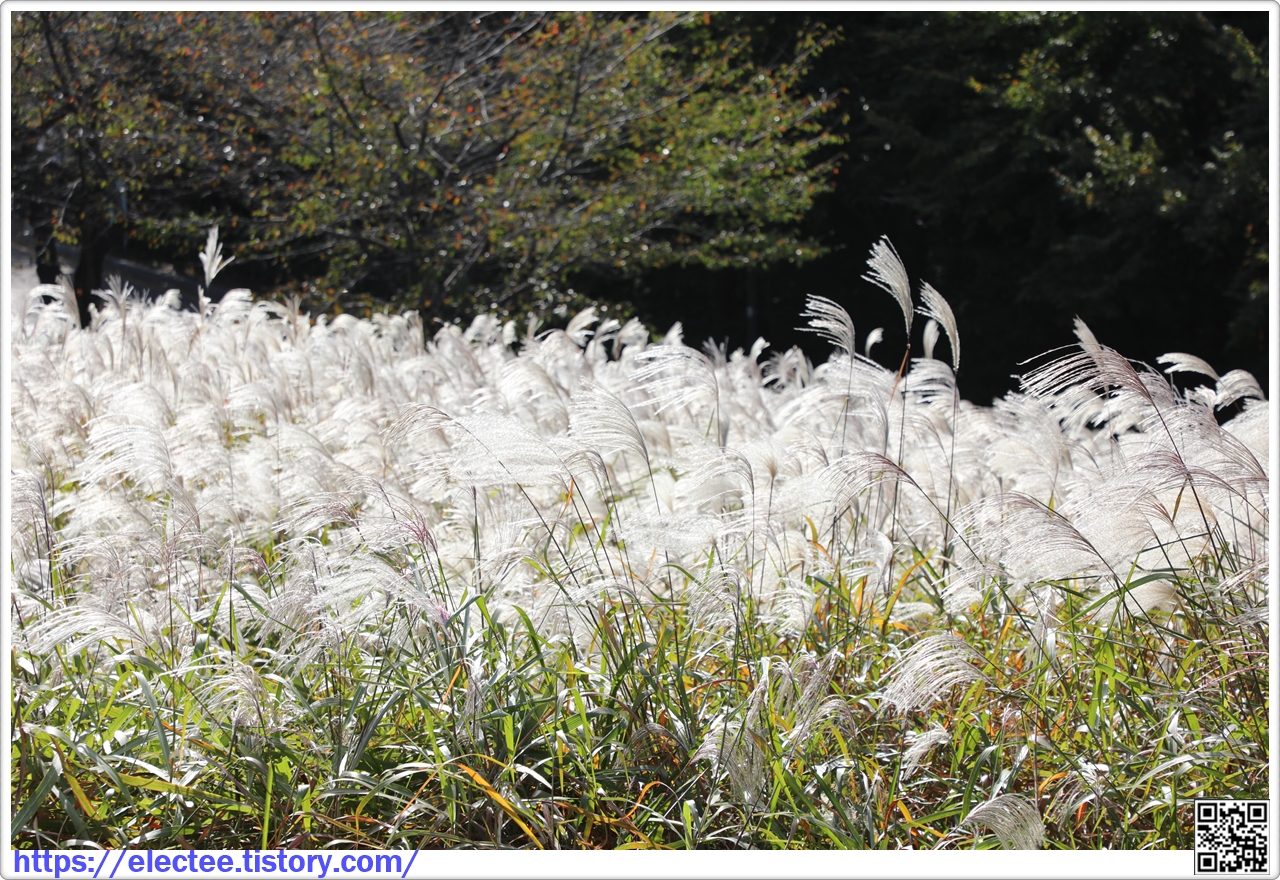
서1치 西1雉
서1치는 서북각루와 서포루 사이에 성벽을 돌출시켜 쌓은 치성이다.
성벽 가까이 접근하는 적을 감시하고 공격하는 역할을 했다.
성벽에 8곳, 용도에 2곳의 치성이 설치되어 있는데 지형에 따라 형태가 조금씩 다르다.
치성은 보통 좌우 방어 시설과 100m 이상 거리를 두고 만들었으나, 서1치는 서북각루에서 약 55m 떨어진 지점에 있다.
화서문에서 뻗은 성벽이 팔달산 정상을 향해 크게 꺾이는 요충지이기 때문에 치성을 가깝게 설치한 것이다.
1) 용도 : 좁고 긴 성벽으로 둘러싸인 통로로 서남암문에서 서남각루에 이르는 길
Western Bastion Ⅰ
A bastion, called chi in Korean, was a structure projecting outward from a fortress wall,
which was designed to attack approaching enemies from the side.
The name chi comes from the Chinese character for pheasant, because pheasants are good at hiding and peeping.
Hwaseong Fortress has a total of 10 bastions.
The Western Bastion Ⅰ is located where the fortress wall is sharply bent between the Northwestern Corner
Pavilion and the Western Artillery Pavilion.
As this was an important defense point, the bastion was built very close to the corner pavilion.
(안내문)

수원 화성 밖에서 보는 풍경은 세 편으로 나누어 이번에 마지막 편을 올렸다.
사진을 찍을 때마다 화성의 모습이 너무 아름답게 느껴진다.
이제 막 물들기 시작하는 단풍은 10여 일 후 절정에 이를 것이다.
그때 시간을 내 다시 방문할 예정이다.
1편이 궁금하면...
성 밖에서 본 수원화성의 참모습 1
2023_164 A 2023. 10. 20. (금) 07:40~12:50, 5시간 10분간 순성, 1시간 10분 휴식 포함, 7.4km 이동 날씨가 좋길래 수원화성을 순성하기로 한다. 지난주 김포와 강화도에서 3일간 보냈고, 엊그제 청계산을 올랐
electee.tistory.com
2편이 궁금하면...
성 밖에서 본 수원화성의 참모습 2
2023_164 B 2023. 10. 20. (금) 07:40~12:50, 5시간 10분간 순성, 1시간 10분 휴식 포함, 7.4km 이동 수원화성의 성 밖 풍경은 모두 3편으로 작성한다. 2편에 해당하는 이번 편은 성벽이 고르게 햇빛을 받아 시원
electee.tistory.com
수원화성의 야경이 궁금하면...
수원화성 야경은 12월 초순이 가장 적기야
2023_202 2023. 12. 4. (월) 18:36~21:36, 3시간 이동, 45분 사진 찍으며 지체, 6.7km 이동 지난번에 원주 강원감영 야경을 본 후 불현듯 수원화성도 야경을 보자는 생각이 들었다. 야경을 볼 때는 해가 짧은 12
electee.tistory.com
'■ 유네스코 세계문화유산 > 산성·고인돌·고분 등' 카테고리의 다른 글
| '23년 남한산성 장경사 주변의 단풍 풍경 (0) | 2023.11.03 |
|---|---|
| '23년 남한산성 수어장대 주변의 단풍 풍경 (0) | 2023.11.02 |
| 수원화성 안에서 즐기는 감성여행 (0) | 2023.10.30 |
| 성 밖에서 본 수원화성의 참모습 2 (0) | 2023.10.23 |
| 성 밖에서 본 수원화성의 참모습 1 (0) | 2023.10.22 |
| 고창 고인돌박물관과 고인돌유적지 (11) | 2023.08.10 |
| 세계문화유산인 부여 나성 살펴보기 (17) | 2023.06.28 |



